Costco and Loblaws Financial Ratios
VerifiedAdded on 2020/03/16
|30
|4882
|424
AI Summary
The assignment provides a dataset of financial ratios calculated for Costco and Loblaws for several years (specifically 2017). It includes metrics like Earnings Per Share (EPS), Price-to-Earnings Ratio (P/E), Dividend Yield, Book Value per Share, and Price-to-Book Ratio. Students are expected to analyze this data to understand the financial health and performance of both companies.
Contribute Materials
Your contribution can guide someone’s learning journey. Share your
documents today.
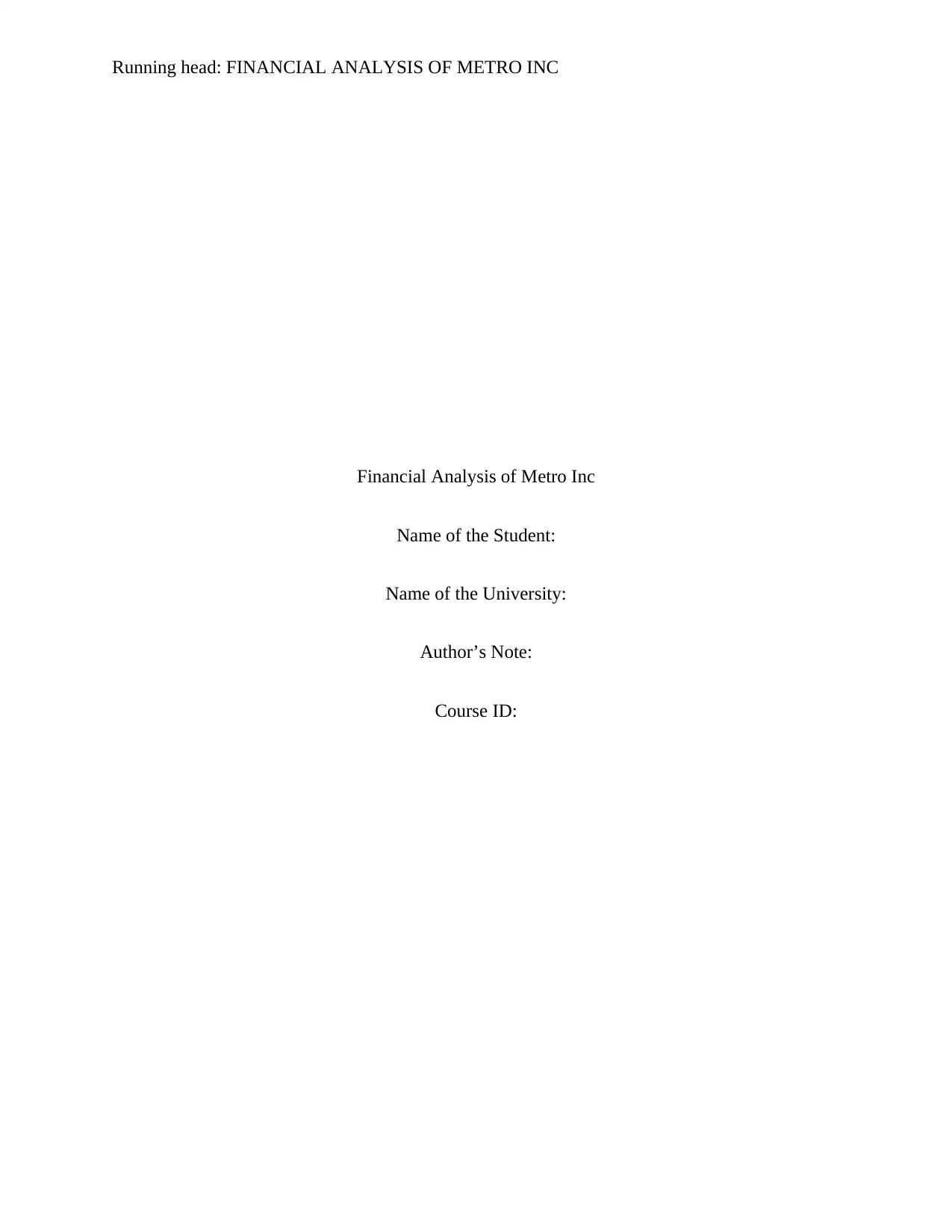
Running head: FINANCIAL ANALYSIS OF METRO INC
Financial Analysis of Metro Inc
Name of the Student:
Name of the University:
Author’s Note:
Course ID:
Financial Analysis of Metro Inc
Name of the Student:
Name of the University:
Author’s Note:
Course ID:
Secure Best Marks with AI Grader
Need help grading? Try our AI Grader for instant feedback on your assignments.
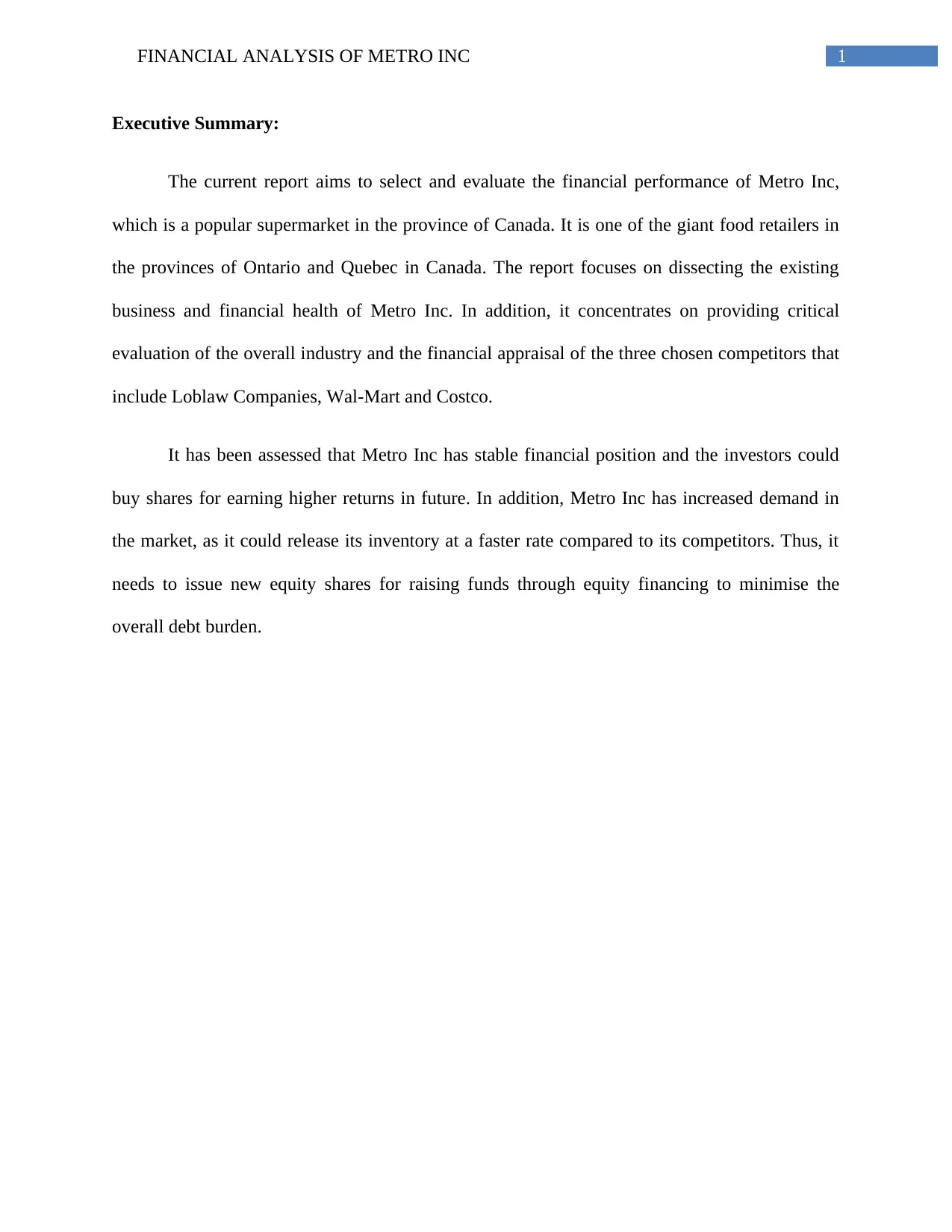
1FINANCIAL ANALYSIS OF METRO INC
Executive Summary:
The current report aims to select and evaluate the financial performance of Metro Inc,
which is a popular supermarket in the province of Canada. It is one of the giant food retailers in
the provinces of Ontario and Quebec in Canada. The report focuses on dissecting the existing
business and financial health of Metro Inc. In addition, it concentrates on providing critical
evaluation of the overall industry and the financial appraisal of the three chosen competitors that
include Loblaw Companies, Wal-Mart and Costco.
It has been assessed that Metro Inc has stable financial position and the investors could
buy shares for earning higher returns in future. In addition, Metro Inc has increased demand in
the market, as it could release its inventory at a faster rate compared to its competitors. Thus, it
needs to issue new equity shares for raising funds through equity financing to minimise the
overall debt burden.
Executive Summary:
The current report aims to select and evaluate the financial performance of Metro Inc,
which is a popular supermarket in the province of Canada. It is one of the giant food retailers in
the provinces of Ontario and Quebec in Canada. The report focuses on dissecting the existing
business and financial health of Metro Inc. In addition, it concentrates on providing critical
evaluation of the overall industry and the financial appraisal of the three chosen competitors that
include Loblaw Companies, Wal-Mart and Costco.
It has been assessed that Metro Inc has stable financial position and the investors could
buy shares for earning higher returns in future. In addition, Metro Inc has increased demand in
the market, as it could release its inventory at a faster rate compared to its competitors. Thus, it
needs to issue new equity shares for raising funds through equity financing to minimise the
overall debt burden.
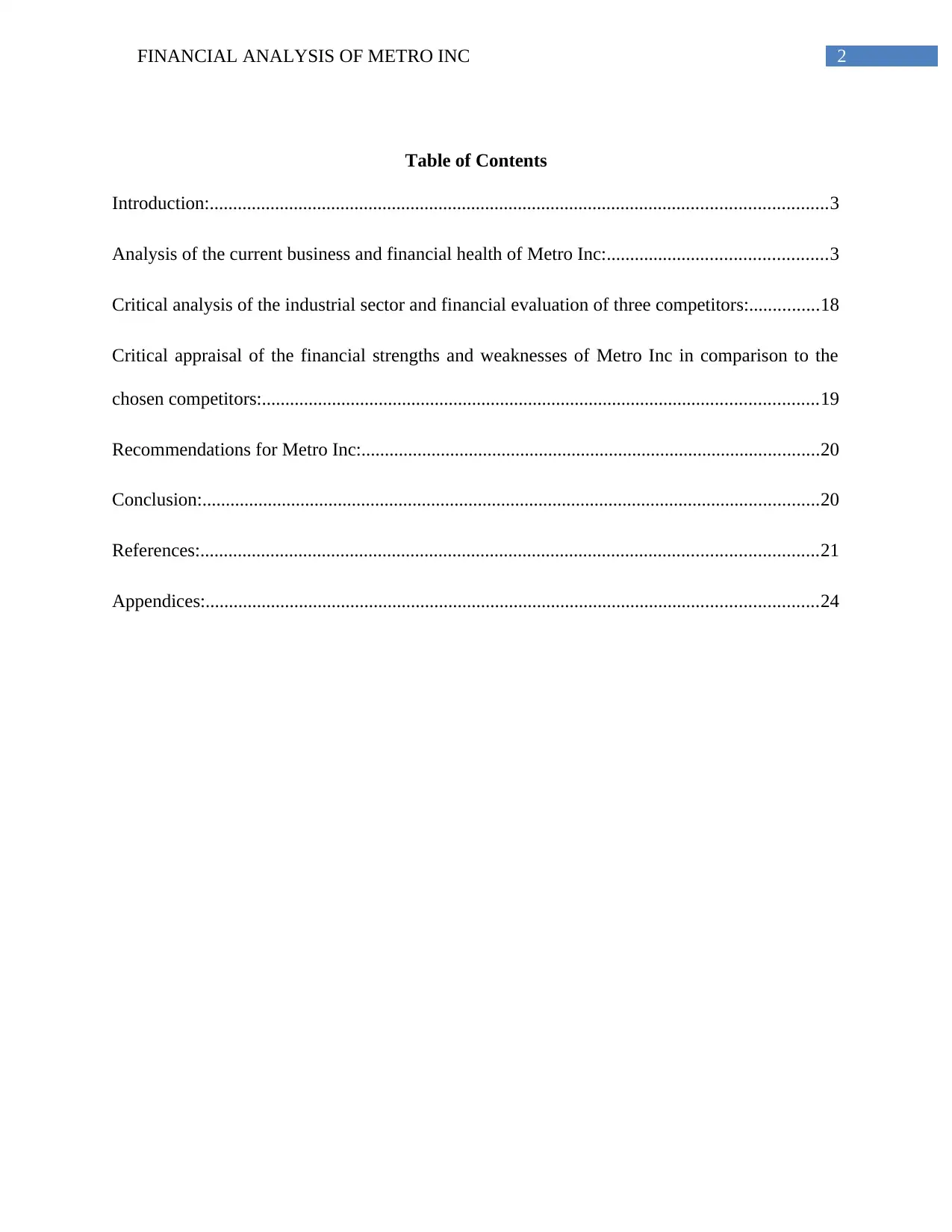
2FINANCIAL ANALYSIS OF METRO INC
Table of Contents
Introduction:....................................................................................................................................3
Analysis of the current business and financial health of Metro Inc:...............................................3
Critical analysis of the industrial sector and financial evaluation of three competitors:...............18
Critical appraisal of the financial strengths and weaknesses of Metro Inc in comparison to the
chosen competitors:.......................................................................................................................19
Recommendations for Metro Inc:..................................................................................................20
Conclusion:....................................................................................................................................20
References:....................................................................................................................................21
Appendices:...................................................................................................................................24
Table of Contents
Introduction:....................................................................................................................................3
Analysis of the current business and financial health of Metro Inc:...............................................3
Critical analysis of the industrial sector and financial evaluation of three competitors:...............18
Critical appraisal of the financial strengths and weaknesses of Metro Inc in comparison to the
chosen competitors:.......................................................................................................................19
Recommendations for Metro Inc:..................................................................................................20
Conclusion:....................................................................................................................................20
References:....................................................................................................................................21
Appendices:...................................................................................................................................24
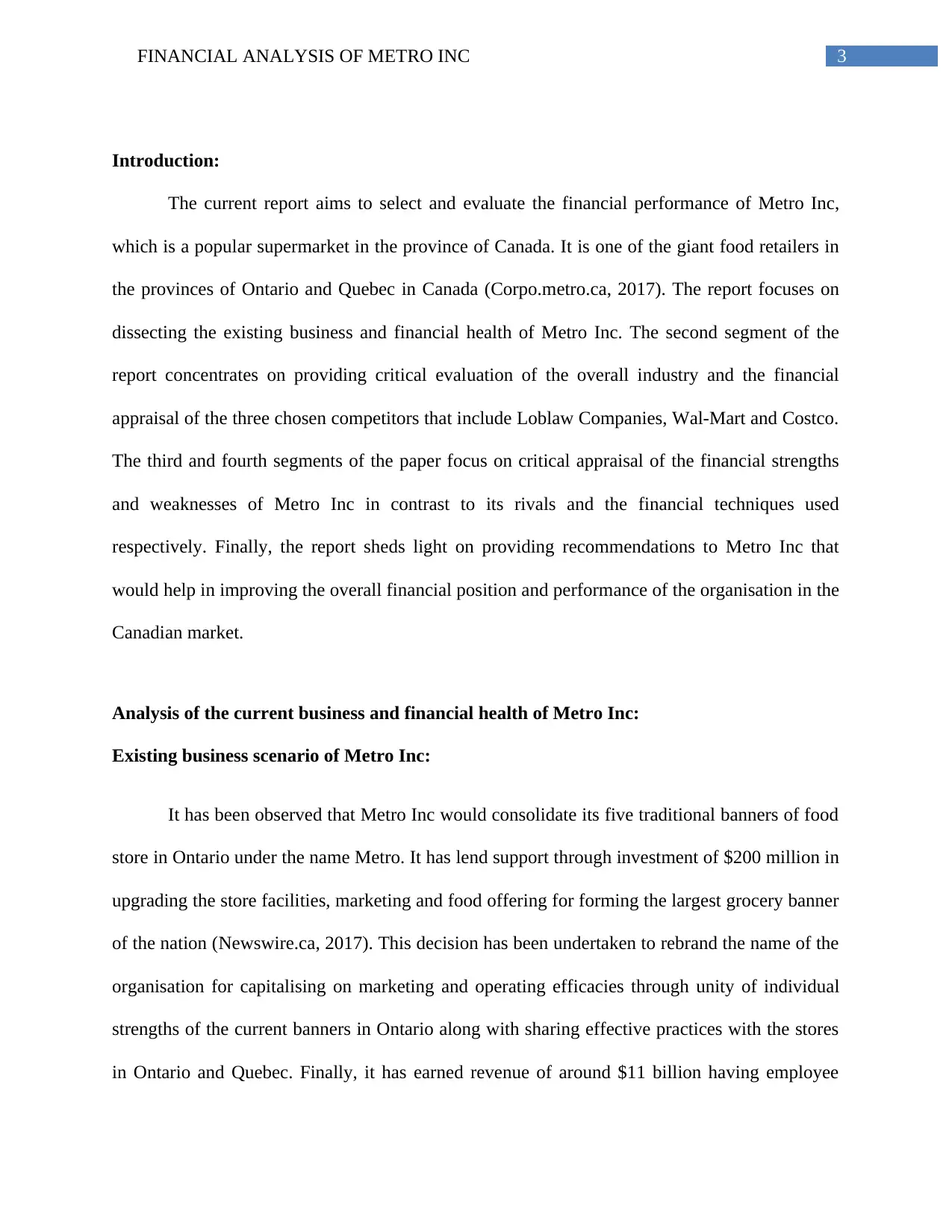
3FINANCIAL ANALYSIS OF METRO INC
Introduction:
The current report aims to select and evaluate the financial performance of Metro Inc,
which is a popular supermarket in the province of Canada. It is one of the giant food retailers in
the provinces of Ontario and Quebec in Canada (Corpo.metro.ca, 2017). The report focuses on
dissecting the existing business and financial health of Metro Inc. The second segment of the
report concentrates on providing critical evaluation of the overall industry and the financial
appraisal of the three chosen competitors that include Loblaw Companies, Wal-Mart and Costco.
The third and fourth segments of the paper focus on critical appraisal of the financial strengths
and weaknesses of Metro Inc in contrast to its rivals and the financial techniques used
respectively. Finally, the report sheds light on providing recommendations to Metro Inc that
would help in improving the overall financial position and performance of the organisation in the
Canadian market.
Analysis of the current business and financial health of Metro Inc:
Existing business scenario of Metro Inc:
It has been observed that Metro Inc would consolidate its five traditional banners of food
store in Ontario under the name Metro. It has lend support through investment of $200 million in
upgrading the store facilities, marketing and food offering for forming the largest grocery banner
of the nation (Newswire.ca, 2017). This decision has been undertaken to rebrand the name of the
organisation for capitalising on marketing and operating efficacies through unity of individual
strengths of the current banners in Ontario along with sharing effective practices with the stores
in Ontario and Quebec. Finally, it has earned revenue of around $11 billion having employee
Introduction:
The current report aims to select and evaluate the financial performance of Metro Inc,
which is a popular supermarket in the province of Canada. It is one of the giant food retailers in
the provinces of Ontario and Quebec in Canada (Corpo.metro.ca, 2017). The report focuses on
dissecting the existing business and financial health of Metro Inc. The second segment of the
report concentrates on providing critical evaluation of the overall industry and the financial
appraisal of the three chosen competitors that include Loblaw Companies, Wal-Mart and Costco.
The third and fourth segments of the paper focus on critical appraisal of the financial strengths
and weaknesses of Metro Inc in contrast to its rivals and the financial techniques used
respectively. Finally, the report sheds light on providing recommendations to Metro Inc that
would help in improving the overall financial position and performance of the organisation in the
Canadian market.
Analysis of the current business and financial health of Metro Inc:
Existing business scenario of Metro Inc:
It has been observed that Metro Inc would consolidate its five traditional banners of food
store in Ontario under the name Metro. It has lend support through investment of $200 million in
upgrading the store facilities, marketing and food offering for forming the largest grocery banner
of the nation (Newswire.ca, 2017). This decision has been undertaken to rebrand the name of the
organisation for capitalising on marketing and operating efficacies through unity of individual
strengths of the current banners in Ontario along with sharing effective practices with the stores
in Ontario and Quebec. Finally, it has earned revenue of around $11 billion having employee
Secure Best Marks with AI Grader
Need help grading? Try our AI Grader for instant feedback on your assignments.

4FINANCIAL ANALYSIS OF METRO INC
base of 65,000, it has become the leader in the Canadian food sector (Brigham & Ehrhardt,
2013).
Financial health of Metro Inc:
The financial health of Metro Inc could be evaluated with the help of ratio analysis, as
this analysis helps in ascertaining the overall financial position and performance of an
organisation in its operating market (Batta, Ganguly & Rosett, 2014). The following categories
of ratios are considered for evaluating the financial health of Metro Inc:
Liquidity category:
In the words of Bodie (2013), liquidity ratios help in gauging the ability of an
organisation in paying debt obligations and safety margin through the computation of various
metrics. These metrics include the following:
Working capital
Acid test ratio
Current ratio
Cash current debt coverage
Receivables turnover
Average collection period (in days)
Inventory turnover
Days in inventory
Days payable
Particulars Details Metro Inc
base of 65,000, it has become the leader in the Canadian food sector (Brigham & Ehrhardt,
2013).
Financial health of Metro Inc:
The financial health of Metro Inc could be evaluated with the help of ratio analysis, as
this analysis helps in ascertaining the overall financial position and performance of an
organisation in its operating market (Batta, Ganguly & Rosett, 2014). The following categories
of ratios are considered for evaluating the financial health of Metro Inc:
Liquidity category:
In the words of Bodie (2013), liquidity ratios help in gauging the ability of an
organisation in paying debt obligations and safety margin through the computation of various
metrics. These metrics include the following:
Working capital
Acid test ratio
Current ratio
Cash current debt coverage
Receivables turnover
Average collection period (in days)
Inventory turnover
Days in inventory
Days payable
Particulars Details Metro Inc
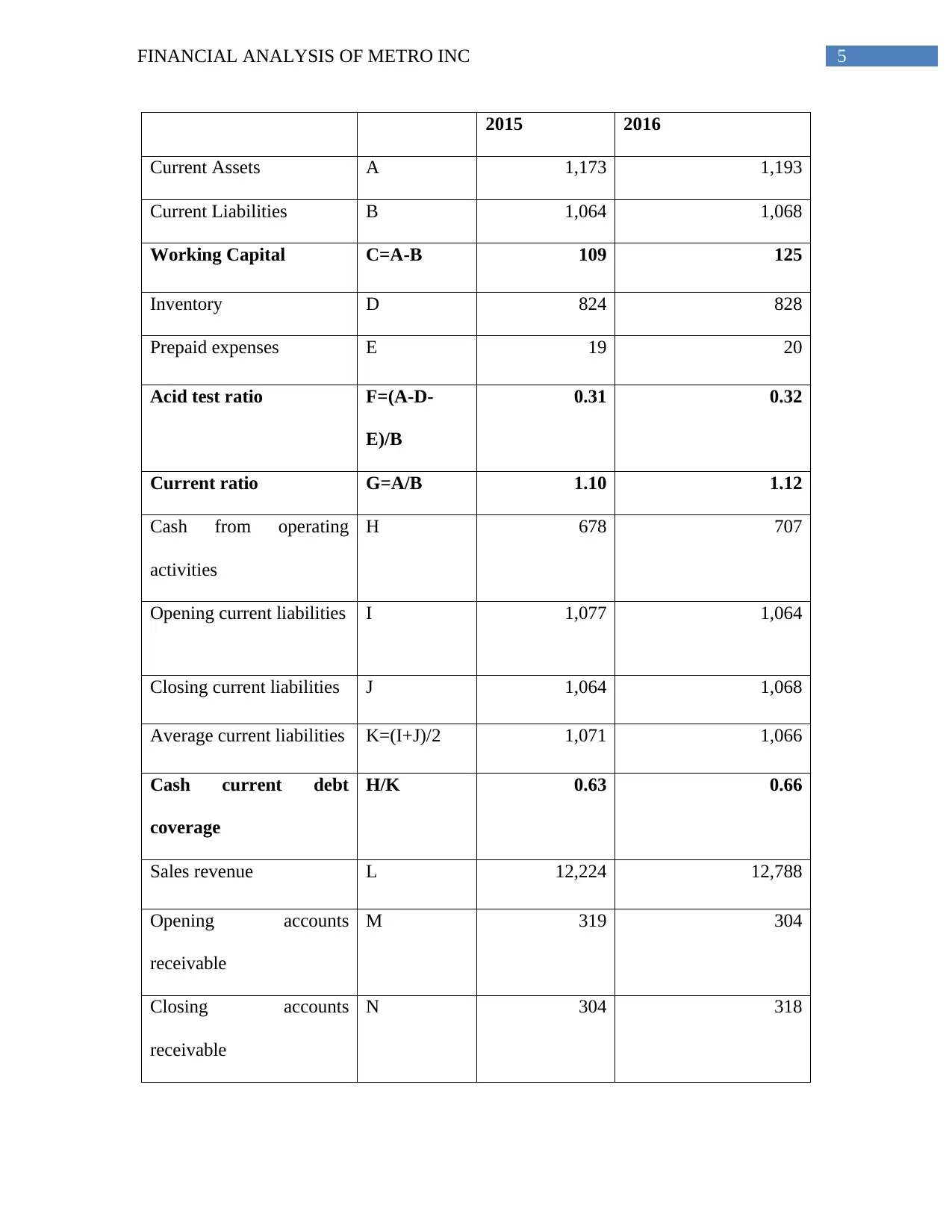
5FINANCIAL ANALYSIS OF METRO INC
2015 2016
Current Assets A 1,173 1,193
Current Liabilities B 1,064 1,068
Working Capital C=A-B 109 125
Inventory D 824 828
Prepaid expenses E 19 20
Acid test ratio F=(A-D-
E)/B
0.31 0.32
Current ratio G=A/B 1.10 1.12
Cash from operating
activities
H 678 707
Opening current liabilities I 1,077 1,064
Closing current liabilities J 1,064 1,068
Average current liabilities K=(I+J)/2 1,071 1,066
Cash current debt
coverage
H/K 0.63 0.66
Sales revenue L 12,224 12,788
Opening accounts
receivable
M 319 304
Closing accounts
receivable
N 304 318
2015 2016
Current Assets A 1,173 1,193
Current Liabilities B 1,064 1,068
Working Capital C=A-B 109 125
Inventory D 824 828
Prepaid expenses E 19 20
Acid test ratio F=(A-D-
E)/B
0.31 0.32
Current ratio G=A/B 1.10 1.12
Cash from operating
activities
H 678 707
Opening current liabilities I 1,077 1,064
Closing current liabilities J 1,064 1,068
Average current liabilities K=(I+J)/2 1,071 1,066
Cash current debt
coverage
H/K 0.63 0.66
Sales revenue L 12,224 12,788
Opening accounts
receivable
M 319 304
Closing accounts
receivable
N 304 318
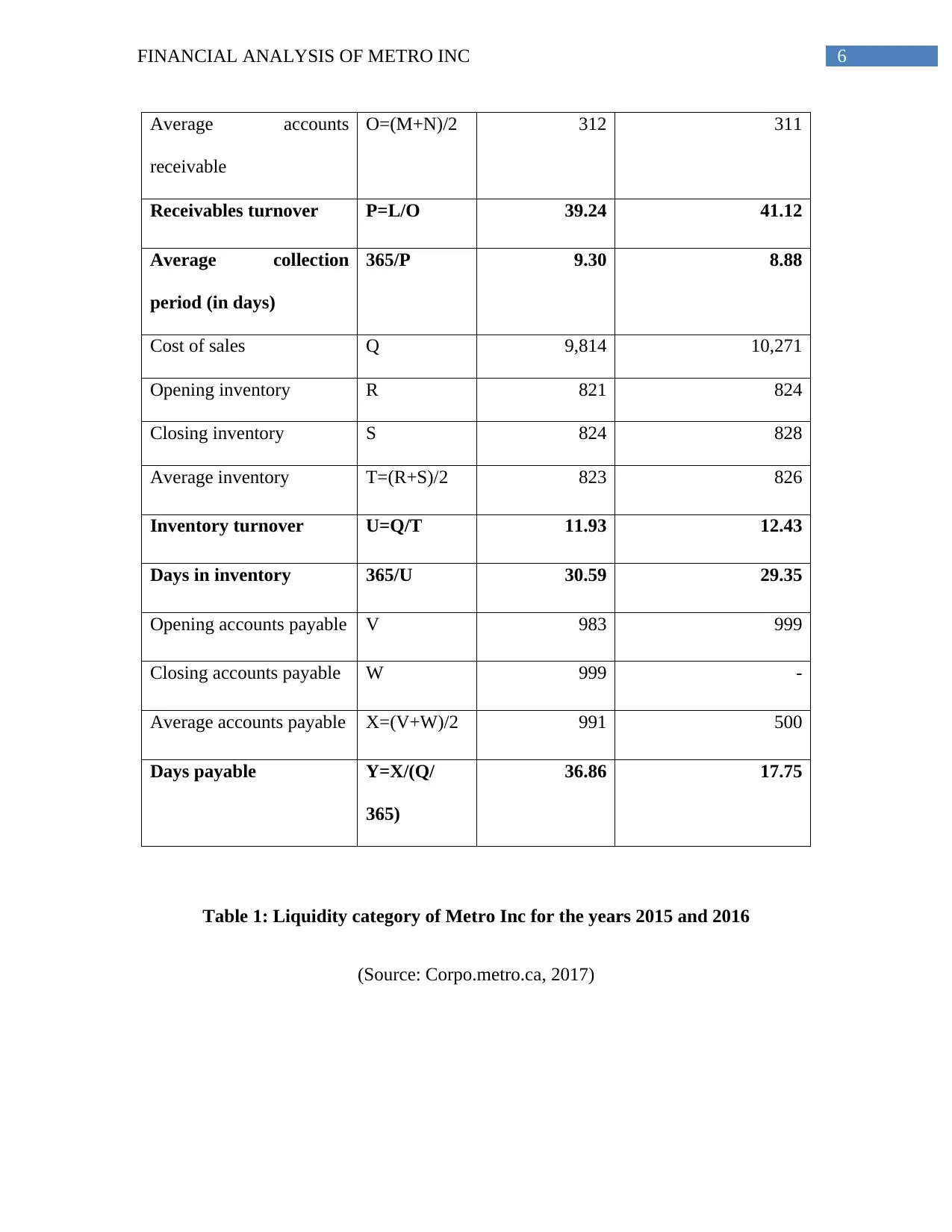
6FINANCIAL ANALYSIS OF METRO INC
Average accounts
receivable
O=(M+N)/2 312 311
Receivables turnover P=L/O 39.24 41.12
Average collection
period (in days)
365/P 9.30 8.88
Cost of sales Q 9,814 10,271
Opening inventory R 821 824
Closing inventory S 824 828
Average inventory T=(R+S)/2 823 826
Inventory turnover U=Q/T 11.93 12.43
Days in inventory 365/U 30.59 29.35
Opening accounts payable V 983 999
Closing accounts payable W 999 -
Average accounts payable X=(V+W)/2 991 500
Days payable Y=X/(Q/
365)
36.86 17.75
Table 1: Liquidity category of Metro Inc for the years 2015 and 2016
(Source: Corpo.metro.ca, 2017)
Average accounts
receivable
O=(M+N)/2 312 311
Receivables turnover P=L/O 39.24 41.12
Average collection
period (in days)
365/P 9.30 8.88
Cost of sales Q 9,814 10,271
Opening inventory R 821 824
Closing inventory S 824 828
Average inventory T=(R+S)/2 823 826
Inventory turnover U=Q/T 11.93 12.43
Days in inventory 365/U 30.59 29.35
Opening accounts payable V 983 999
Closing accounts payable W 999 -
Average accounts payable X=(V+W)/2 991 500
Days payable Y=X/(Q/
365)
36.86 17.75
Table 1: Liquidity category of Metro Inc for the years 2015 and 2016
(Source: Corpo.metro.ca, 2017)
Paraphrase This Document
Need a fresh take? Get an instant paraphrase of this document with our AI Paraphraser
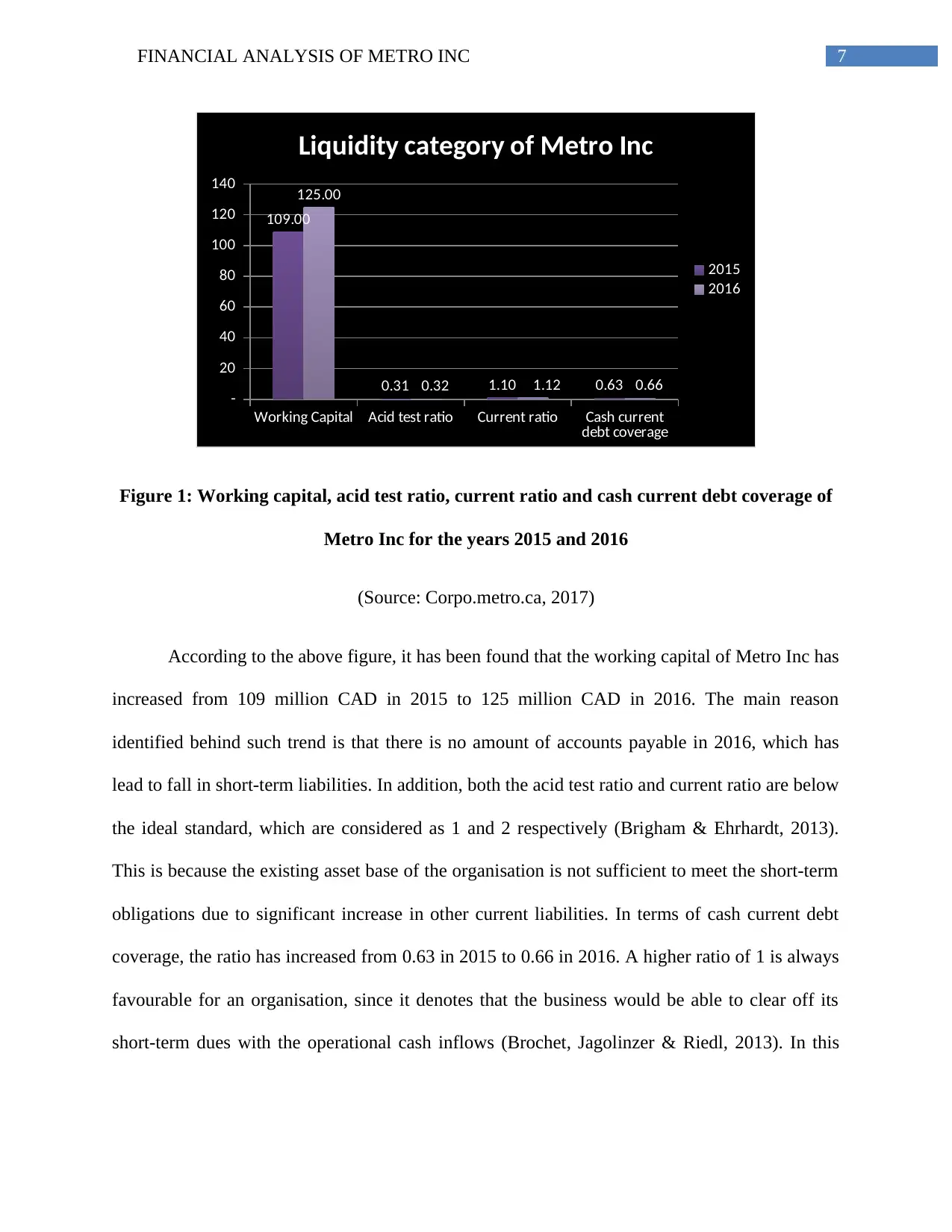
7FINANCIAL ANALYSIS OF METRO INC
Working Capital Acid test ratio Current ratio Cash current
debt coverage
-
20
40
60
80
100
120
140
109.00
0.31 1.10 0.63
125.00
0.32 1.12 0.66
Liquidity category of Metro Inc
2015
2016
Figure 1: Working capital, acid test ratio, current ratio and cash current debt coverage of
Metro Inc for the years 2015 and 2016
(Source: Corpo.metro.ca, 2017)
According to the above figure, it has been found that the working capital of Metro Inc has
increased from 109 million CAD in 2015 to 125 million CAD in 2016. The main reason
identified behind such trend is that there is no amount of accounts payable in 2016, which has
lead to fall in short-term liabilities. In addition, both the acid test ratio and current ratio are below
the ideal standard, which are considered as 1 and 2 respectively (Brigham & Ehrhardt, 2013).
This is because the existing asset base of the organisation is not sufficient to meet the short-term
obligations due to significant increase in other current liabilities. In terms of cash current debt
coverage, the ratio has increased from 0.63 in 2015 to 0.66 in 2016. A higher ratio of 1 is always
favourable for an organisation, since it denotes that the business would be able to clear off its
short-term dues with the operational cash inflows (Brochet, Jagolinzer & Riedl, 2013). In this
Working Capital Acid test ratio Current ratio Cash current
debt coverage
-
20
40
60
80
100
120
140
109.00
0.31 1.10 0.63
125.00
0.32 1.12 0.66
Liquidity category of Metro Inc
2015
2016
Figure 1: Working capital, acid test ratio, current ratio and cash current debt coverage of
Metro Inc for the years 2015 and 2016
(Source: Corpo.metro.ca, 2017)
According to the above figure, it has been found that the working capital of Metro Inc has
increased from 109 million CAD in 2015 to 125 million CAD in 2016. The main reason
identified behind such trend is that there is no amount of accounts payable in 2016, which has
lead to fall in short-term liabilities. In addition, both the acid test ratio and current ratio are below
the ideal standard, which are considered as 1 and 2 respectively (Brigham & Ehrhardt, 2013).
This is because the existing asset base of the organisation is not sufficient to meet the short-term
obligations due to significant increase in other current liabilities. In terms of cash current debt
coverage, the ratio has increased from 0.63 in 2015 to 0.66 in 2016. A higher ratio of 1 is always
favourable for an organisation, since it denotes that the business would be able to clear off its
short-term dues with the operational cash inflows (Brochet, Jagolinzer & Riedl, 2013). In this
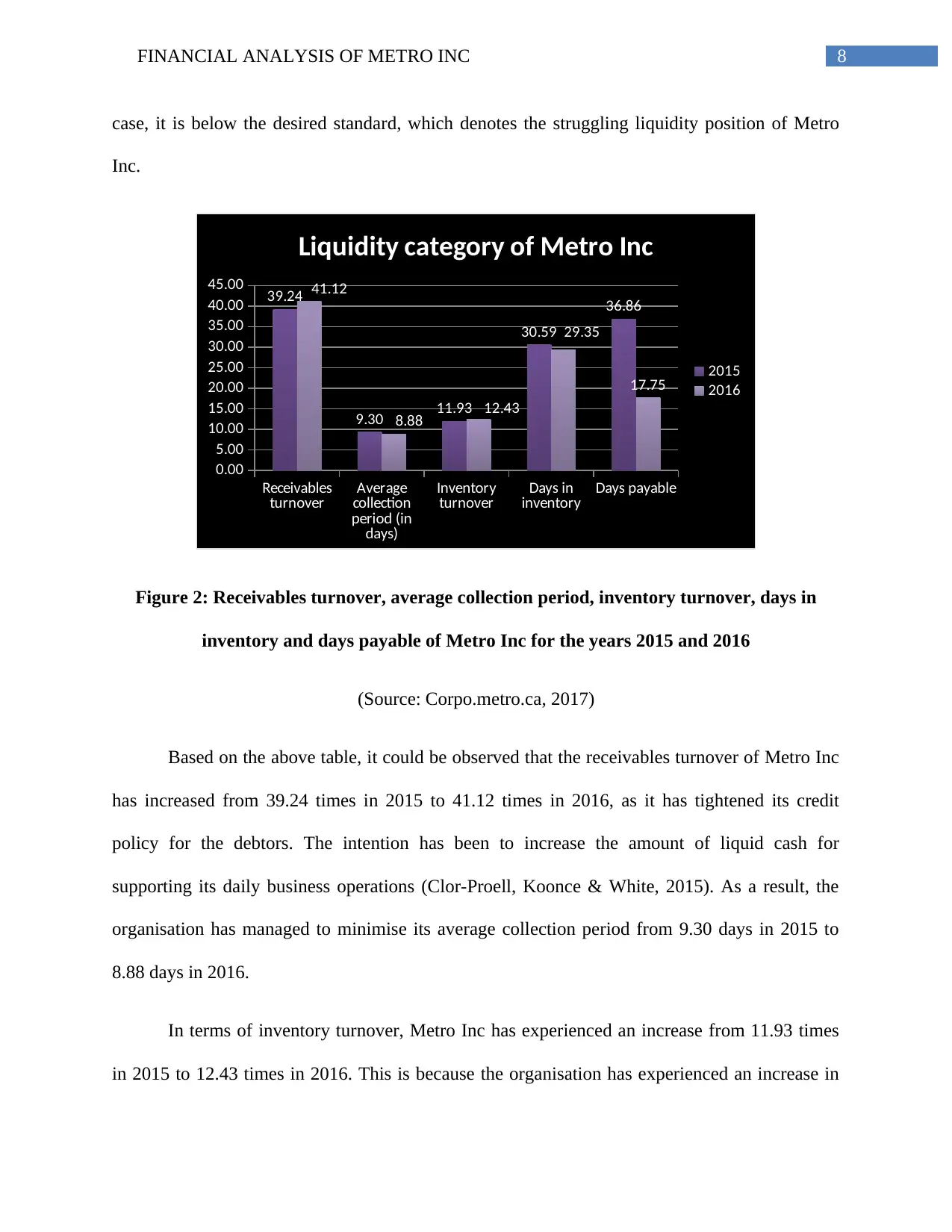
8FINANCIAL ANALYSIS OF METRO INC
case, it is below the desired standard, which denotes the struggling liquidity position of Metro
Inc.
Receivables
turnover Average
collection
period (in
days)
Inventory
turnover Days in
inventory Days payable
0.00
5.00
10.00
15.00
20.00
25.00
30.00
35.00
40.00
45.00 39.24
9.30 11.93
30.59
36.86
41.12
8.88 12.43
29.35
17.75
Liquidity category of Metro Inc
2015
2016
Figure 2: Receivables turnover, average collection period, inventory turnover, days in
inventory and days payable of Metro Inc for the years 2015 and 2016
(Source: Corpo.metro.ca, 2017)
Based on the above table, it could be observed that the receivables turnover of Metro Inc
has increased from 39.24 times in 2015 to 41.12 times in 2016, as it has tightened its credit
policy for the debtors. The intention has been to increase the amount of liquid cash for
supporting its daily business operations (Clor-Proell, Koonce & White, 2015). As a result, the
organisation has managed to minimise its average collection period from 9.30 days in 2015 to
8.88 days in 2016.
In terms of inventory turnover, Metro Inc has experienced an increase from 11.93 times
in 2015 to 12.43 times in 2016. This is because the organisation has experienced an increase in
case, it is below the desired standard, which denotes the struggling liquidity position of Metro
Inc.
Receivables
turnover Average
collection
period (in
days)
Inventory
turnover Days in
inventory Days payable
0.00
5.00
10.00
15.00
20.00
25.00
30.00
35.00
40.00
45.00 39.24
9.30 11.93
30.59
36.86
41.12
8.88 12.43
29.35
17.75
Liquidity category of Metro Inc
2015
2016
Figure 2: Receivables turnover, average collection period, inventory turnover, days in
inventory and days payable of Metro Inc for the years 2015 and 2016
(Source: Corpo.metro.ca, 2017)
Based on the above table, it could be observed that the receivables turnover of Metro Inc
has increased from 39.24 times in 2015 to 41.12 times in 2016, as it has tightened its credit
policy for the debtors. The intention has been to increase the amount of liquid cash for
supporting its daily business operations (Clor-Proell, Koonce & White, 2015). As a result, the
organisation has managed to minimise its average collection period from 9.30 days in 2015 to
8.88 days in 2016.
In terms of inventory turnover, Metro Inc has experienced an increase from 11.93 times
in 2015 to 12.43 times in 2016. This is because the organisation has experienced an increase in
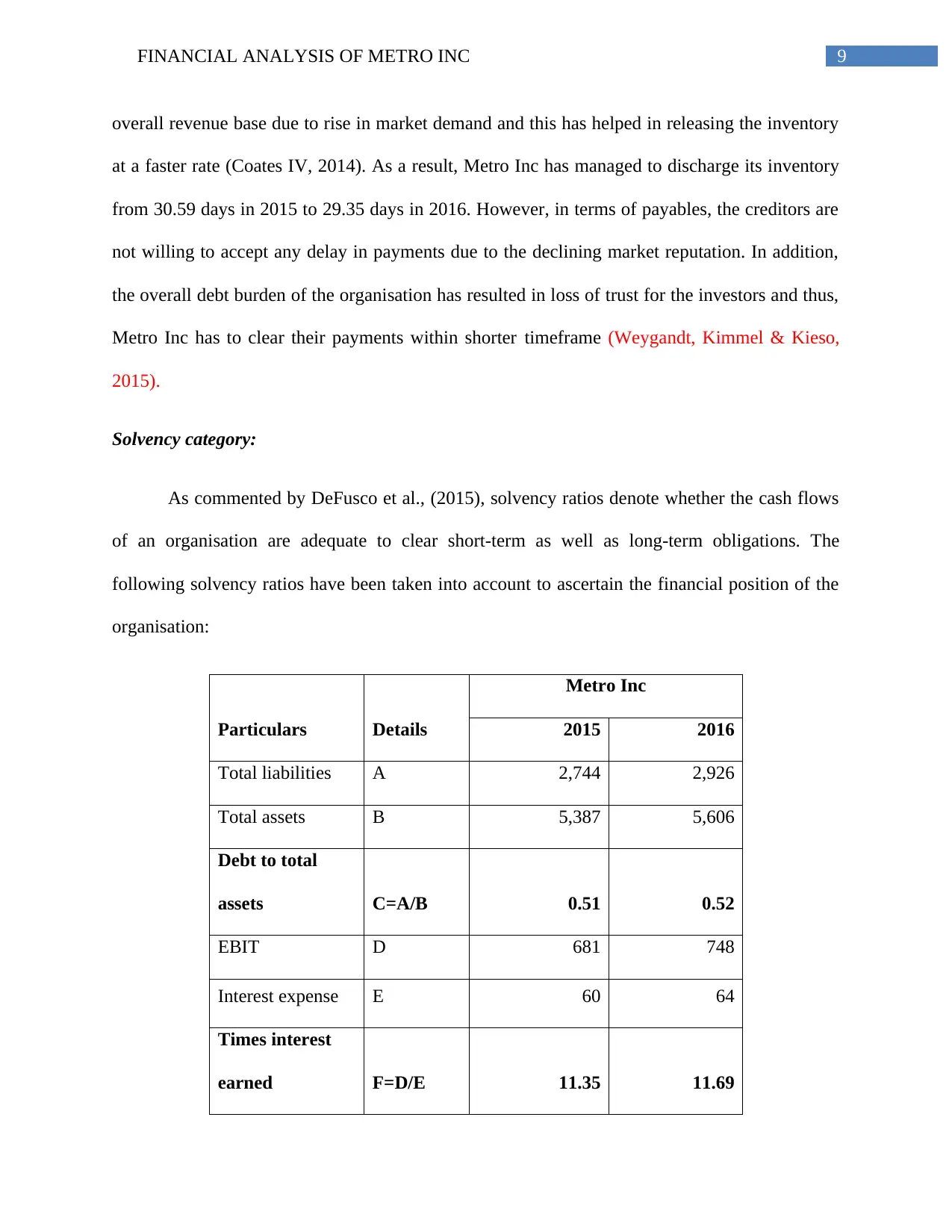
9FINANCIAL ANALYSIS OF METRO INC
overall revenue base due to rise in market demand and this has helped in releasing the inventory
at a faster rate (Coates IV, 2014). As a result, Metro Inc has managed to discharge its inventory
from 30.59 days in 2015 to 29.35 days in 2016. However, in terms of payables, the creditors are
not willing to accept any delay in payments due to the declining market reputation. In addition,
the overall debt burden of the organisation has resulted in loss of trust for the investors and thus,
Metro Inc has to clear their payments within shorter timeframe (Weygandt, Kimmel & Kieso,
2015).
Solvency category:
As commented by DeFusco et al., (2015), solvency ratios denote whether the cash flows
of an organisation are adequate to clear short-term as well as long-term obligations. The
following solvency ratios have been taken into account to ascertain the financial position of the
organisation:
Particulars Details
Metro Inc
2015 2016
Total liabilities A 2,744 2,926
Total assets B 5,387 5,606
Debt to total
assets C=A/B 0.51 0.52
EBIT D 681 748
Interest expense E 60 64
Times interest
earned F=D/E 11.35 11.69
overall revenue base due to rise in market demand and this has helped in releasing the inventory
at a faster rate (Coates IV, 2014). As a result, Metro Inc has managed to discharge its inventory
from 30.59 days in 2015 to 29.35 days in 2016. However, in terms of payables, the creditors are
not willing to accept any delay in payments due to the declining market reputation. In addition,
the overall debt burden of the organisation has resulted in loss of trust for the investors and thus,
Metro Inc has to clear their payments within shorter timeframe (Weygandt, Kimmel & Kieso,
2015).
Solvency category:
As commented by DeFusco et al., (2015), solvency ratios denote whether the cash flows
of an organisation are adequate to clear short-term as well as long-term obligations. The
following solvency ratios have been taken into account to ascertain the financial position of the
organisation:
Particulars Details
Metro Inc
2015 2016
Total liabilities A 2,744 2,926
Total assets B 5,387 5,606
Debt to total
assets C=A/B 0.51 0.52
EBIT D 681 748
Interest expense E 60 64
Times interest
earned F=D/E 11.35 11.69
Secure Best Marks with AI Grader
Need help grading? Try our AI Grader for instant feedback on your assignments.
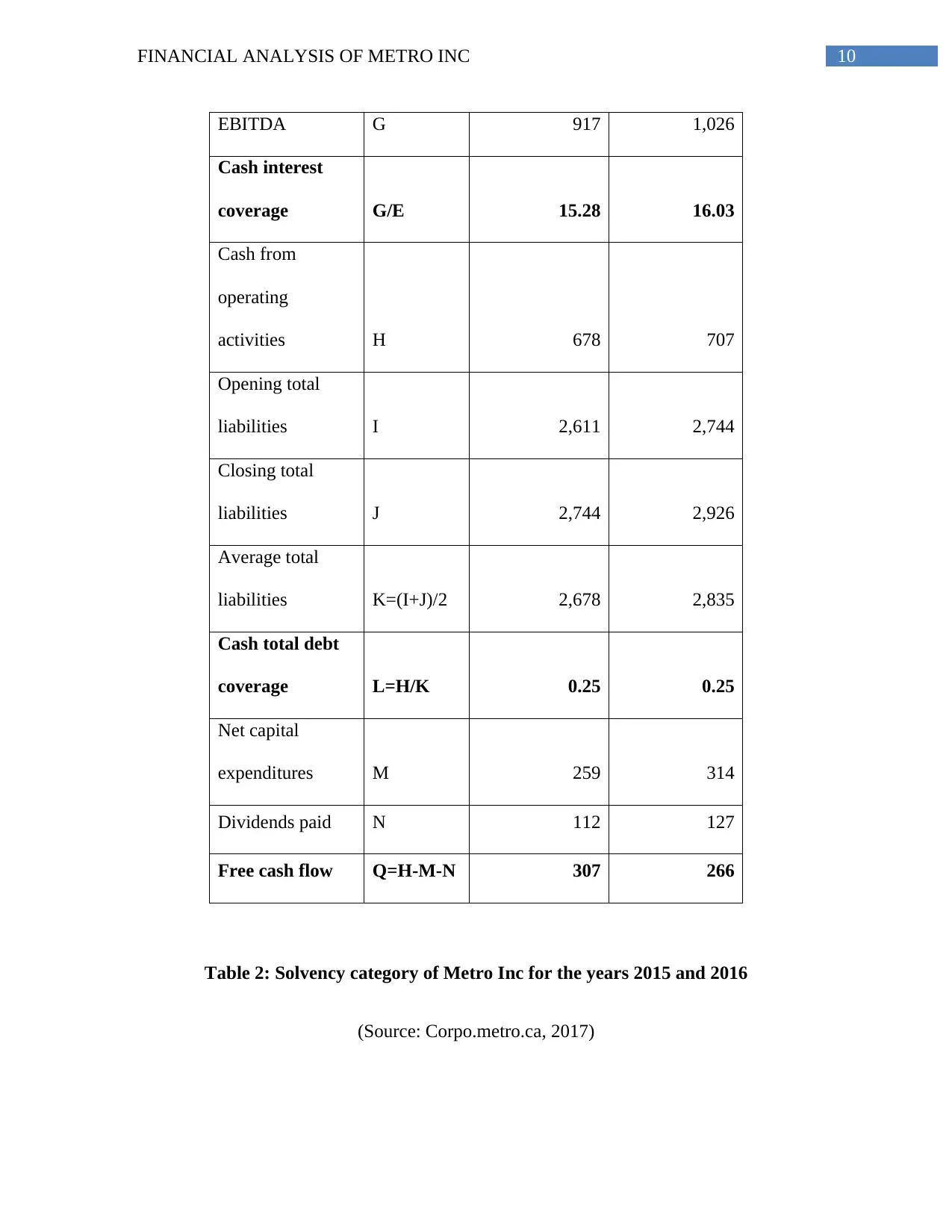
10FINANCIAL ANALYSIS OF METRO INC
EBITDA G 917 1,026
Cash interest
coverage G/E 15.28 16.03
Cash from
operating
activities H 678 707
Opening total
liabilities I 2,611 2,744
Closing total
liabilities J 2,744 2,926
Average total
liabilities K=(I+J)/2 2,678 2,835
Cash total debt
coverage L=H/K 0.25 0.25
Net capital
expenditures M 259 314
Dividends paid N 112 127
Free cash flow Q=H-M-N 307 266
Table 2: Solvency category of Metro Inc for the years 2015 and 2016
(Source: Corpo.metro.ca, 2017)
EBITDA G 917 1,026
Cash interest
coverage G/E 15.28 16.03
Cash from
operating
activities H 678 707
Opening total
liabilities I 2,611 2,744
Closing total
liabilities J 2,744 2,926
Average total
liabilities K=(I+J)/2 2,678 2,835
Cash total debt
coverage L=H/K 0.25 0.25
Net capital
expenditures M 259 314
Dividends paid N 112 127
Free cash flow Q=H-M-N 307 266
Table 2: Solvency category of Metro Inc for the years 2015 and 2016
(Source: Corpo.metro.ca, 2017)
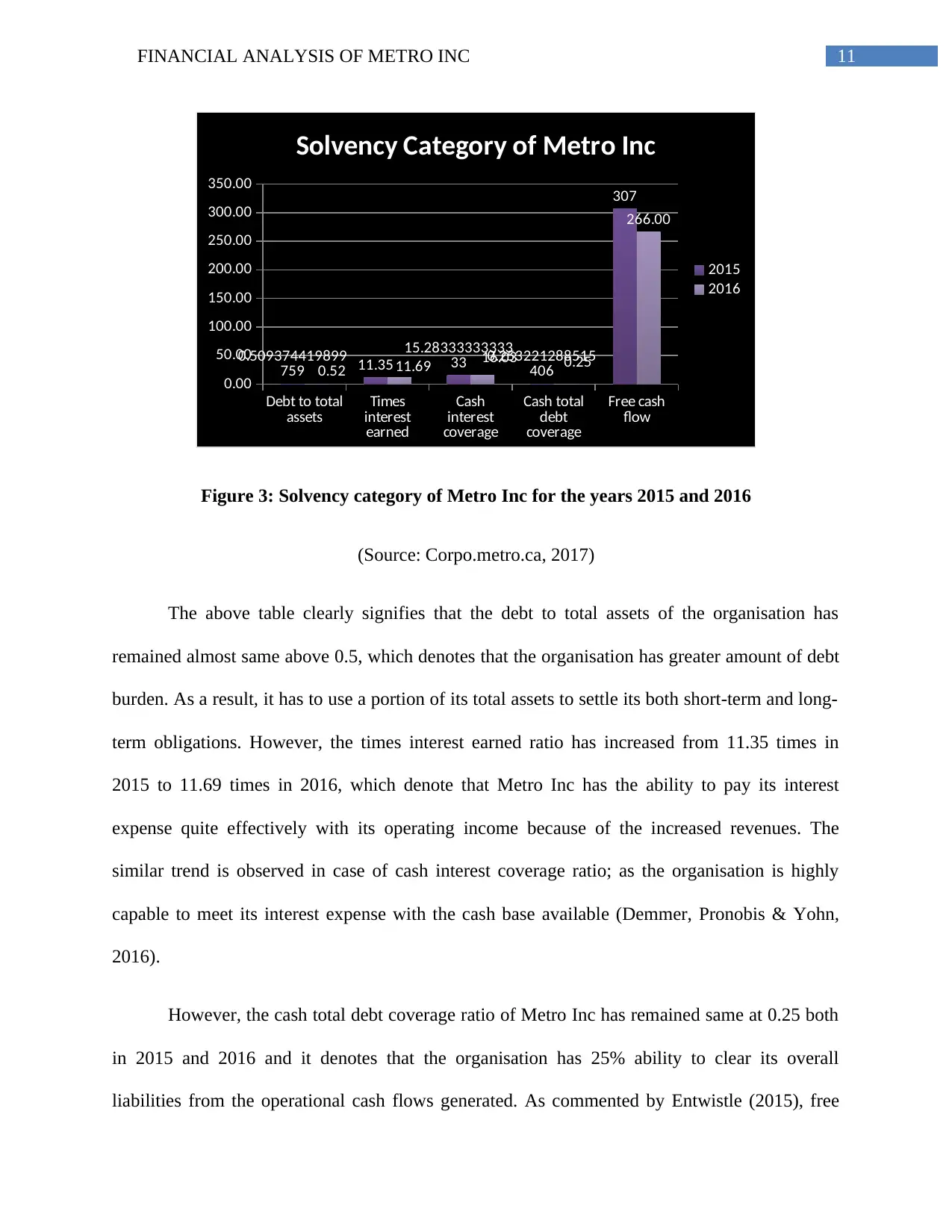
11FINANCIAL ANALYSIS OF METRO INC
Debt to total
assets Times
interest
earned
Cash
interest
coverage
Cash total
debt
coverage
Free cash
flow
0.00
50.00
100.00
150.00
200.00
250.00
300.00
350.00
0.509374419899
759 11.35
15.28333333333
33 0.253221288515
406
307
0.52 11.69 16.03 0.25
266.00
Solvency Category of Metro Inc
2015
2016
Figure 3: Solvency category of Metro Inc for the years 2015 and 2016
(Source: Corpo.metro.ca, 2017)
The above table clearly signifies that the debt to total assets of the organisation has
remained almost same above 0.5, which denotes that the organisation has greater amount of debt
burden. As a result, it has to use a portion of its total assets to settle its both short-term and long-
term obligations. However, the times interest earned ratio has increased from 11.35 times in
2015 to 11.69 times in 2016, which denote that Metro Inc has the ability to pay its interest
expense quite effectively with its operating income because of the increased revenues. The
similar trend is observed in case of cash interest coverage ratio; as the organisation is highly
capable to meet its interest expense with the cash base available (Demmer, Pronobis & Yohn,
2016).
However, the cash total debt coverage ratio of Metro Inc has remained same at 0.25 both
in 2015 and 2016 and it denotes that the organisation has 25% ability to clear its overall
liabilities from the operational cash flows generated. As commented by Entwistle (2015), free
Debt to total
assets Times
interest
earned
Cash
interest
coverage
Cash total
debt
coverage
Free cash
flow
0.00
50.00
100.00
150.00
200.00
250.00
300.00
350.00
0.509374419899
759 11.35
15.28333333333
33 0.253221288515
406
307
0.52 11.69 16.03 0.25
266.00
Solvency Category of Metro Inc
2015
2016
Figure 3: Solvency category of Metro Inc for the years 2015 and 2016
(Source: Corpo.metro.ca, 2017)
The above table clearly signifies that the debt to total assets of the organisation has
remained almost same above 0.5, which denotes that the organisation has greater amount of debt
burden. As a result, it has to use a portion of its total assets to settle its both short-term and long-
term obligations. However, the times interest earned ratio has increased from 11.35 times in
2015 to 11.69 times in 2016, which denote that Metro Inc has the ability to pay its interest
expense quite effectively with its operating income because of the increased revenues. The
similar trend is observed in case of cash interest coverage ratio; as the organisation is highly
capable to meet its interest expense with the cash base available (Demmer, Pronobis & Yohn,
2016).
However, the cash total debt coverage ratio of Metro Inc has remained same at 0.25 both
in 2015 and 2016 and it denotes that the organisation has 25% ability to clear its overall
liabilities from the operational cash flows generated. As commented by Entwistle (2015), free
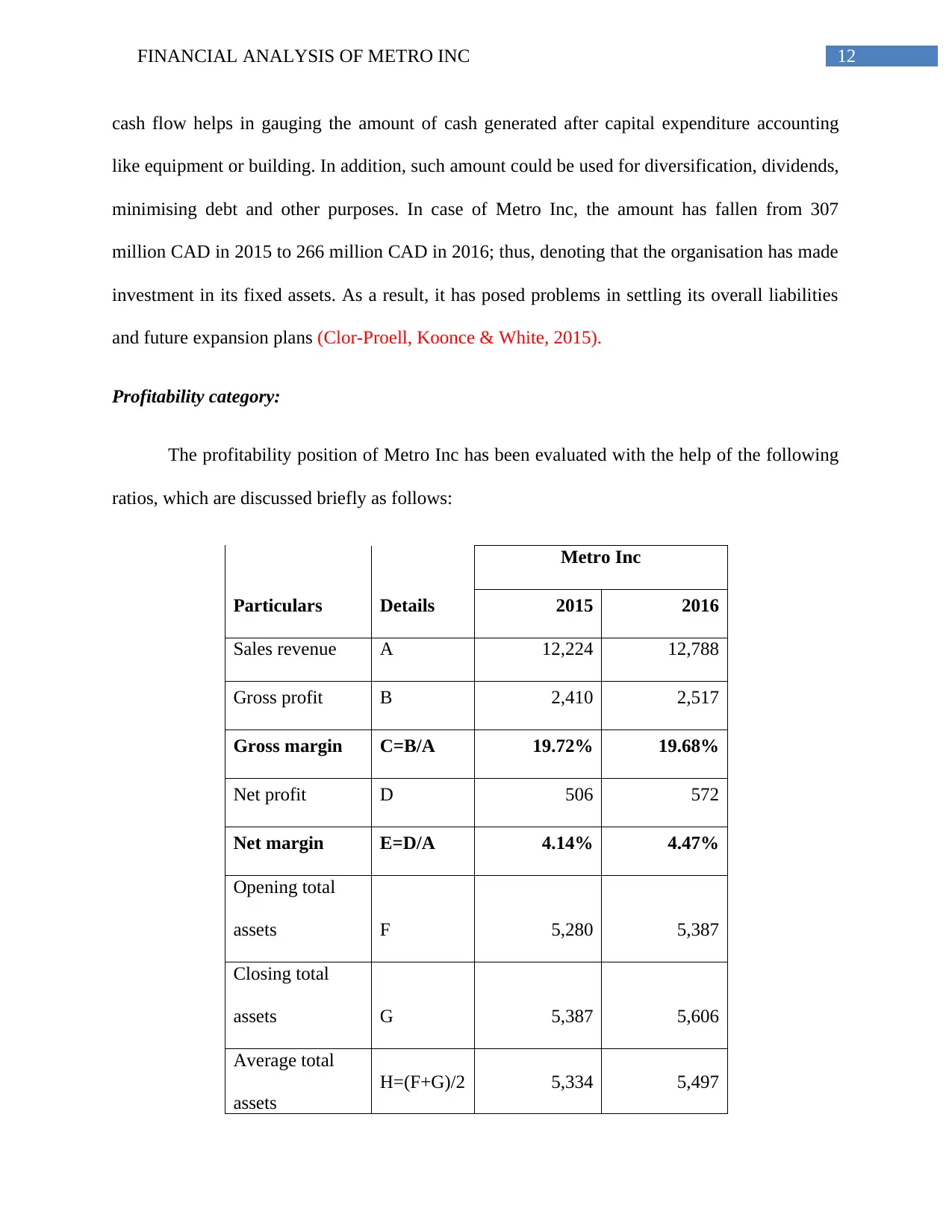
12FINANCIAL ANALYSIS OF METRO INC
cash flow helps in gauging the amount of cash generated after capital expenditure accounting
like equipment or building. In addition, such amount could be used for diversification, dividends,
minimising debt and other purposes. In case of Metro Inc, the amount has fallen from 307
million CAD in 2015 to 266 million CAD in 2016; thus, denoting that the organisation has made
investment in its fixed assets. As a result, it has posed problems in settling its overall liabilities
and future expansion plans (Clor-Proell, Koonce & White, 2015).
Profitability category:
The profitability position of Metro Inc has been evaluated with the help of the following
ratios, which are discussed briefly as follows:
Particulars Details
Metro Inc
2015 2016
Sales revenue A 12,224 12,788
Gross profit B 2,410 2,517
Gross margin C=B/A 19.72% 19.68%
Net profit D 506 572
Net margin E=D/A 4.14% 4.47%
Opening total
assets F 5,280 5,387
Closing total
assets G 5,387 5,606
Average total
assets
H=(F+G)/2 5,334 5,497
cash flow helps in gauging the amount of cash generated after capital expenditure accounting
like equipment or building. In addition, such amount could be used for diversification, dividends,
minimising debt and other purposes. In case of Metro Inc, the amount has fallen from 307
million CAD in 2015 to 266 million CAD in 2016; thus, denoting that the organisation has made
investment in its fixed assets. As a result, it has posed problems in settling its overall liabilities
and future expansion plans (Clor-Proell, Koonce & White, 2015).
Profitability category:
The profitability position of Metro Inc has been evaluated with the help of the following
ratios, which are discussed briefly as follows:
Particulars Details
Metro Inc
2015 2016
Sales revenue A 12,224 12,788
Gross profit B 2,410 2,517
Gross margin C=B/A 19.72% 19.68%
Net profit D 506 572
Net margin E=D/A 4.14% 4.47%
Opening total
assets F 5,280 5,387
Closing total
assets G 5,387 5,606
Average total
assets
H=(F+G)/2 5,334 5,497
Paraphrase This Document
Need a fresh take? Get an instant paraphrase of this document with our AI Paraphraser
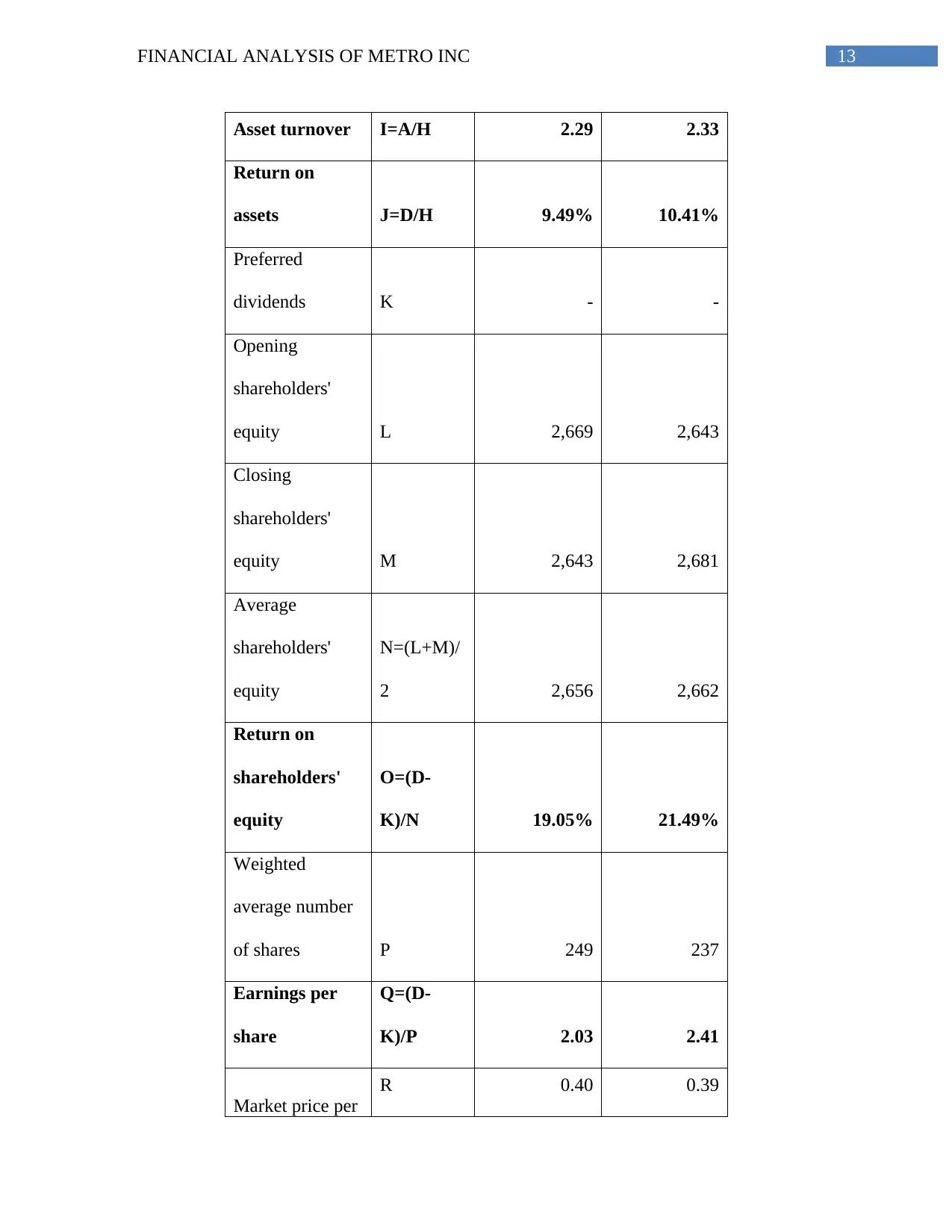
13FINANCIAL ANALYSIS OF METRO INC
Asset turnover I=A/H 2.29 2.33
Return on
assets J=D/H 9.49% 10.41%
Preferred
dividends K - -
Opening
shareholders'
equity L 2,669 2,643
Closing
shareholders'
equity M 2,643 2,681
Average
shareholders'
equity
N=(L+M)/
2 2,656 2,662
Return on
shareholders'
equity
O=(D-
K)/N 19.05% 21.49%
Weighted
average number
of shares P 249 237
Earnings per
share
Q=(D-
K)/P 2.03 2.41
Market price per
R 0.40 0.39
Asset turnover I=A/H 2.29 2.33
Return on
assets J=D/H 9.49% 10.41%
Preferred
dividends K - -
Opening
shareholders'
equity L 2,669 2,643
Closing
shareholders'
equity M 2,643 2,681
Average
shareholders'
equity
N=(L+M)/
2 2,656 2,662
Return on
shareholders'
equity
O=(D-
K)/N 19.05% 21.49%
Weighted
average number
of shares P 249 237
Earnings per
share
Q=(D-
K)/P 2.03 2.41
Market price per
R 0.40 0.39
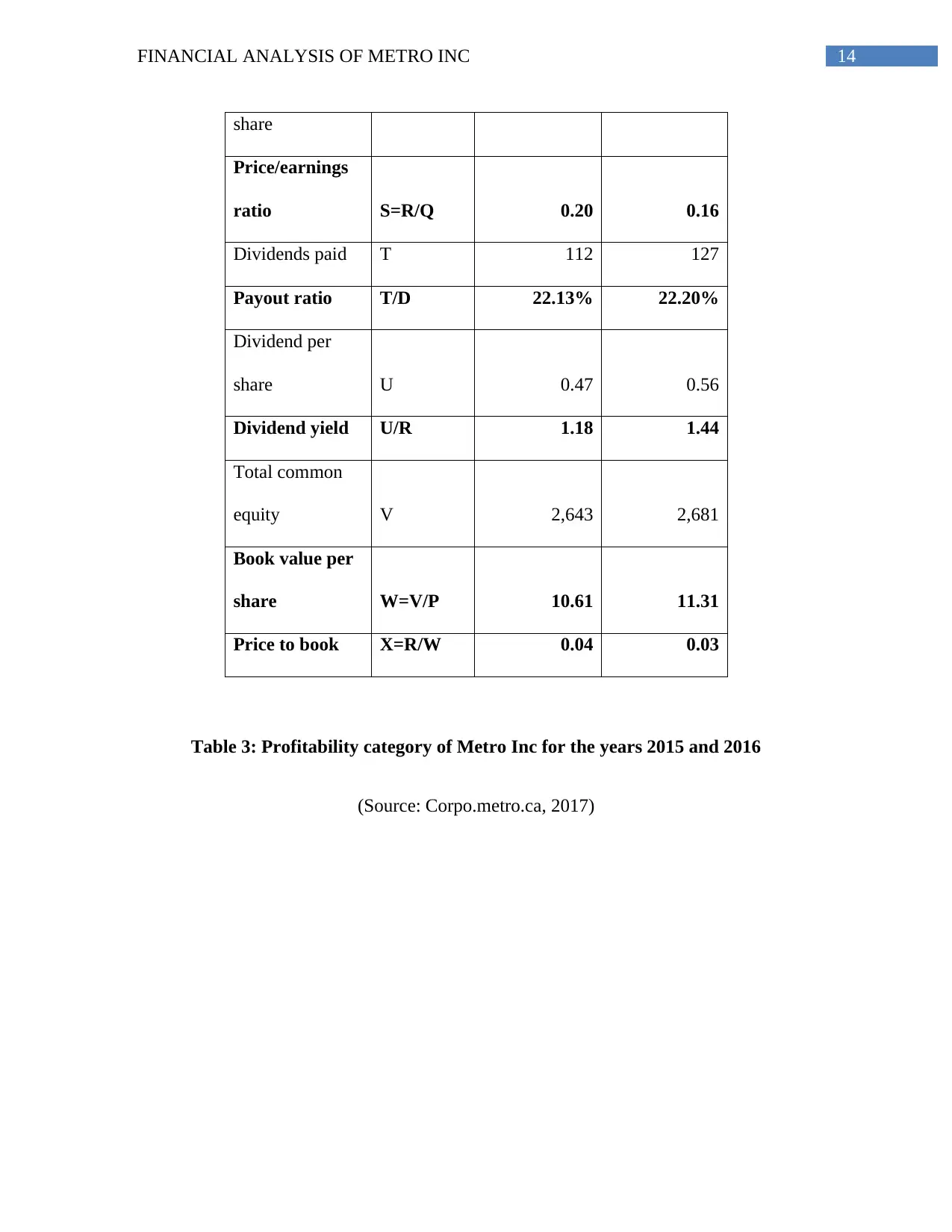
14FINANCIAL ANALYSIS OF METRO INC
share
Price/earnings
ratio S=R/Q 0.20 0.16
Dividends paid T 112 127
Payout ratio T/D 22.13% 22.20%
Dividend per
share U 0.47 0.56
Dividend yield U/R 1.18 1.44
Total common
equity V 2,643 2,681
Book value per
share W=V/P 10.61 11.31
Price to book X=R/W 0.04 0.03
Table 3: Profitability category of Metro Inc for the years 2015 and 2016
(Source: Corpo.metro.ca, 2017)
share
Price/earnings
ratio S=R/Q 0.20 0.16
Dividends paid T 112 127
Payout ratio T/D 22.13% 22.20%
Dividend per
share U 0.47 0.56
Dividend yield U/R 1.18 1.44
Total common
equity V 2,643 2,681
Book value per
share W=V/P 10.61 11.31
Price to book X=R/W 0.04 0.03
Table 3: Profitability category of Metro Inc for the years 2015 and 2016
(Source: Corpo.metro.ca, 2017)
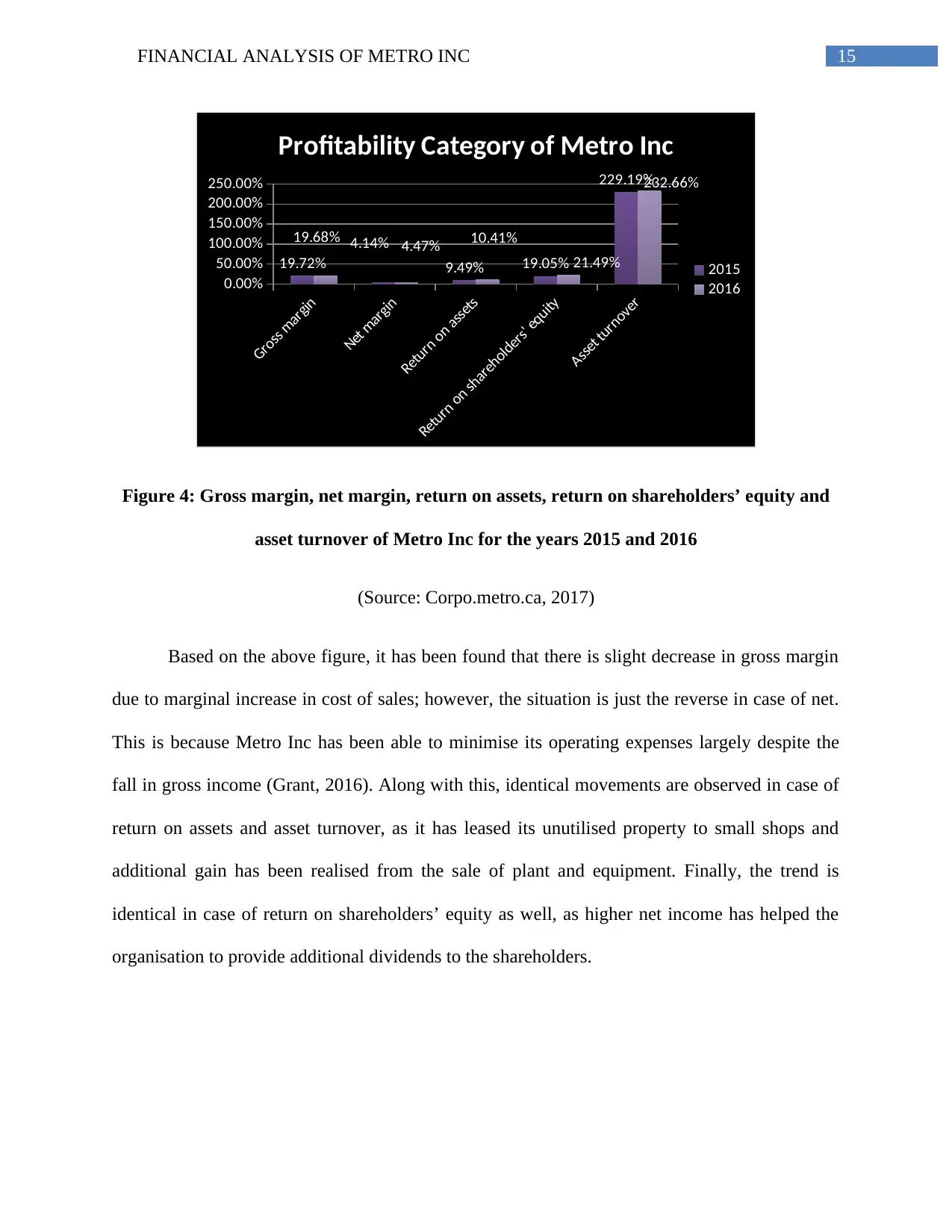
15FINANCIAL ANALYSIS OF METRO INC
Gross margin
Net margin
Return on assets
Return on shareholders' equity
Asset turnover
0.00%
50.00%
100.00%
150.00%
200.00%
250.00%
19.72%
4.14%
9.49% 19.05%
229.19%
19.68% 4.47% 10.41%
21.49%
232.66%
Profitability Category of Metro Inc
2015
2016
Figure 4: Gross margin, net margin, return on assets, return on shareholders’ equity and
asset turnover of Metro Inc for the years 2015 and 2016
(Source: Corpo.metro.ca, 2017)
Based on the above figure, it has been found that there is slight decrease in gross margin
due to marginal increase in cost of sales; however, the situation is just the reverse in case of net.
This is because Metro Inc has been able to minimise its operating expenses largely despite the
fall in gross income (Grant, 2016). Along with this, identical movements are observed in case of
return on assets and asset turnover, as it has leased its unutilised property to small shops and
additional gain has been realised from the sale of plant and equipment. Finally, the trend is
identical in case of return on shareholders’ equity as well, as higher net income has helped the
organisation to provide additional dividends to the shareholders.
Gross margin
Net margin
Return on assets
Return on shareholders' equity
Asset turnover
0.00%
50.00%
100.00%
150.00%
200.00%
250.00%
19.72%
4.14%
9.49% 19.05%
229.19%
19.68% 4.47% 10.41%
21.49%
232.66%
Profitability Category of Metro Inc
2015
2016
Figure 4: Gross margin, net margin, return on assets, return on shareholders’ equity and
asset turnover of Metro Inc for the years 2015 and 2016
(Source: Corpo.metro.ca, 2017)
Based on the above figure, it has been found that there is slight decrease in gross margin
due to marginal increase in cost of sales; however, the situation is just the reverse in case of net.
This is because Metro Inc has been able to minimise its operating expenses largely despite the
fall in gross income (Grant, 2016). Along with this, identical movements are observed in case of
return on assets and asset turnover, as it has leased its unutilised property to small shops and
additional gain has been realised from the sale of plant and equipment. Finally, the trend is
identical in case of return on shareholders’ equity as well, as higher net income has helped the
organisation to provide additional dividends to the shareholders.
Secure Best Marks with AI Grader
Need help grading? Try our AI Grader for instant feedback on your assignments.
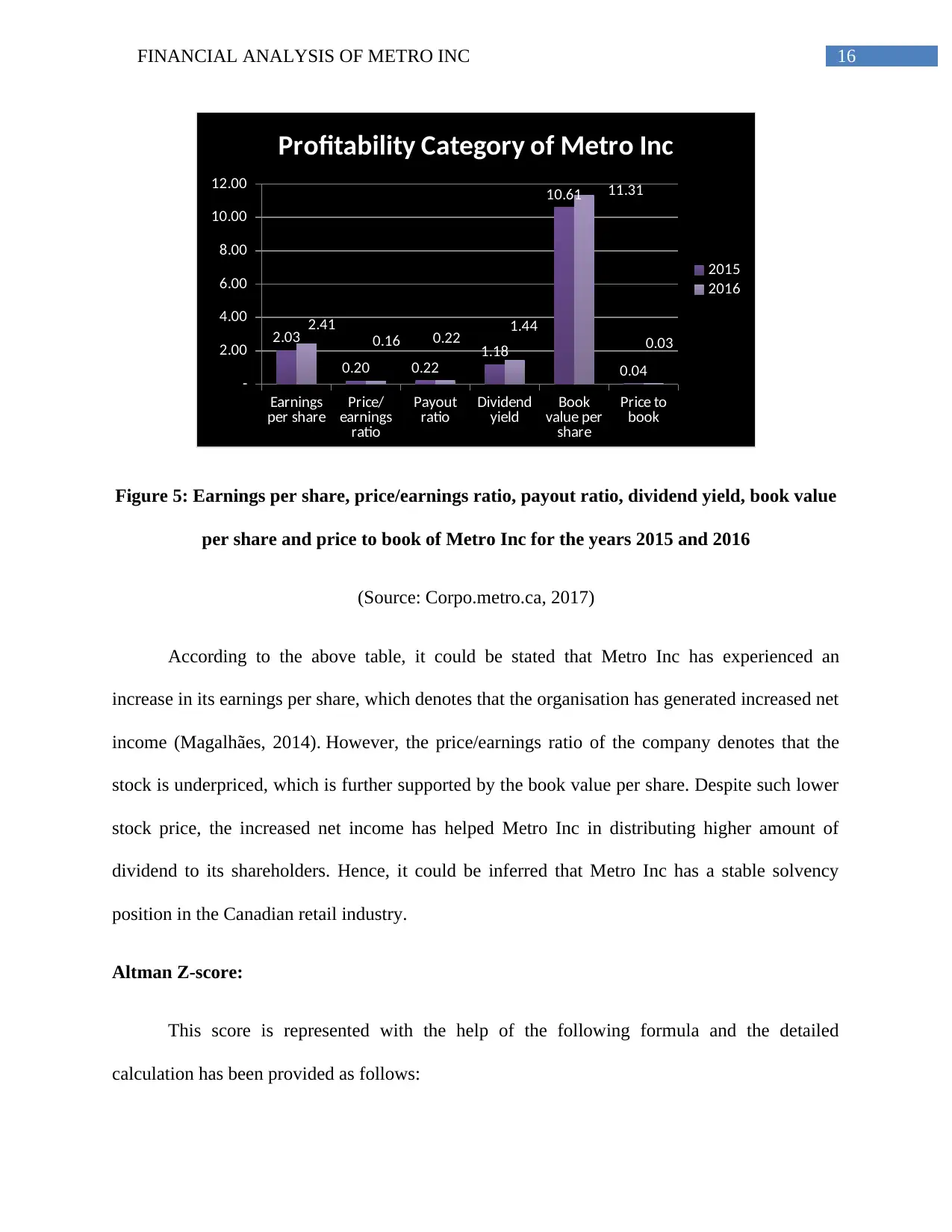
16FINANCIAL ANALYSIS OF METRO INC
Earnings
per share Price/
earnings
ratio
Payout
ratio Dividend
yield Book
value per
share
Price to
book
-
2.00
4.00
6.00
8.00
10.00
12.00
2.03
0.20 0.22
1.18
10.61
0.04
2.41
0.16 0.22 1.44
11.31
0.03
Profitability Category of Metro Inc
2015
2016
Figure 5: Earnings per share, price/earnings ratio, payout ratio, dividend yield, book value
per share and price to book of Metro Inc for the years 2015 and 2016
(Source: Corpo.metro.ca, 2017)
According to the above table, it could be stated that Metro Inc has experienced an
increase in its earnings per share, which denotes that the organisation has generated increased net
income (Magalhães, 2014). However, the price/earnings ratio of the company denotes that the
stock is underpriced, which is further supported by the book value per share. Despite such lower
stock price, the increased net income has helped Metro Inc in distributing higher amount of
dividend to its shareholders. Hence, it could be inferred that Metro Inc has a stable solvency
position in the Canadian retail industry.
Altman Z-score:
This score is represented with the help of the following formula and the detailed
calculation has been provided as follows:
Earnings
per share Price/
earnings
ratio
Payout
ratio Dividend
yield Book
value per
share
Price to
book
-
2.00
4.00
6.00
8.00
10.00
12.00
2.03
0.20 0.22
1.18
10.61
0.04
2.41
0.16 0.22 1.44
11.31
0.03
Profitability Category of Metro Inc
2015
2016
Figure 5: Earnings per share, price/earnings ratio, payout ratio, dividend yield, book value
per share and price to book of Metro Inc for the years 2015 and 2016
(Source: Corpo.metro.ca, 2017)
According to the above table, it could be stated that Metro Inc has experienced an
increase in its earnings per share, which denotes that the organisation has generated increased net
income (Magalhães, 2014). However, the price/earnings ratio of the company denotes that the
stock is underpriced, which is further supported by the book value per share. Despite such lower
stock price, the increased net income has helped Metro Inc in distributing higher amount of
dividend to its shareholders. Hence, it could be inferred that Metro Inc has a stable solvency
position in the Canadian retail industry.
Altman Z-score:
This score is represented with the help of the following formula and the detailed
calculation has been provided as follows:
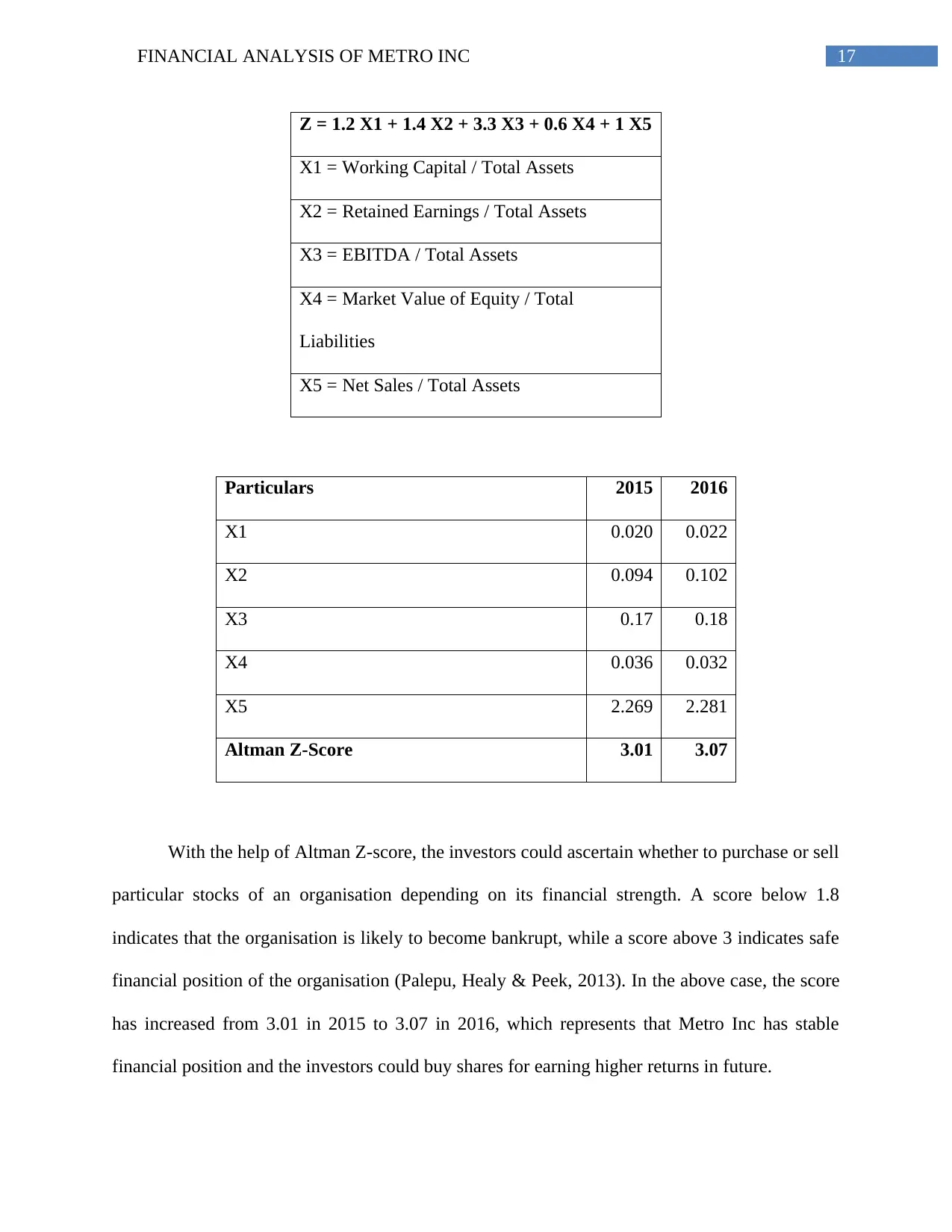
17FINANCIAL ANALYSIS OF METRO INC
Z = 1.2 X1 + 1.4 X2 + 3.3 X3 + 0.6 X4 + 1 X5
X1 = Working Capital / Total Assets
X2 = Retained Earnings / Total Assets
X3 = EBITDA / Total Assets
X4 = Market Value of Equity / Total
Liabilities
X5 = Net Sales / Total Assets
Particulars 2015 2016
X1 0.020 0.022
X2 0.094 0.102
X3 0.17 0.18
X4 0.036 0.032
X5 2.269 2.281
Altman Z-Score 3.01 3.07
With the help of Altman Z-score, the investors could ascertain whether to purchase or sell
particular stocks of an organisation depending on its financial strength. A score below 1.8
indicates that the organisation is likely to become bankrupt, while a score above 3 indicates safe
financial position of the organisation (Palepu, Healy & Peek, 2013). In the above case, the score
has increased from 3.01 in 2015 to 3.07 in 2016, which represents that Metro Inc has stable
financial position and the investors could buy shares for earning higher returns in future.
Z = 1.2 X1 + 1.4 X2 + 3.3 X3 + 0.6 X4 + 1 X5
X1 = Working Capital / Total Assets
X2 = Retained Earnings / Total Assets
X3 = EBITDA / Total Assets
X4 = Market Value of Equity / Total
Liabilities
X5 = Net Sales / Total Assets
Particulars 2015 2016
X1 0.020 0.022
X2 0.094 0.102
X3 0.17 0.18
X4 0.036 0.032
X5 2.269 2.281
Altman Z-Score 3.01 3.07
With the help of Altman Z-score, the investors could ascertain whether to purchase or sell
particular stocks of an organisation depending on its financial strength. A score below 1.8
indicates that the organisation is likely to become bankrupt, while a score above 3 indicates safe
financial position of the organisation (Palepu, Healy & Peek, 2013). In the above case, the score
has increased from 3.01 in 2015 to 3.07 in 2016, which represents that Metro Inc has stable
financial position and the investors could buy shares for earning higher returns in future.
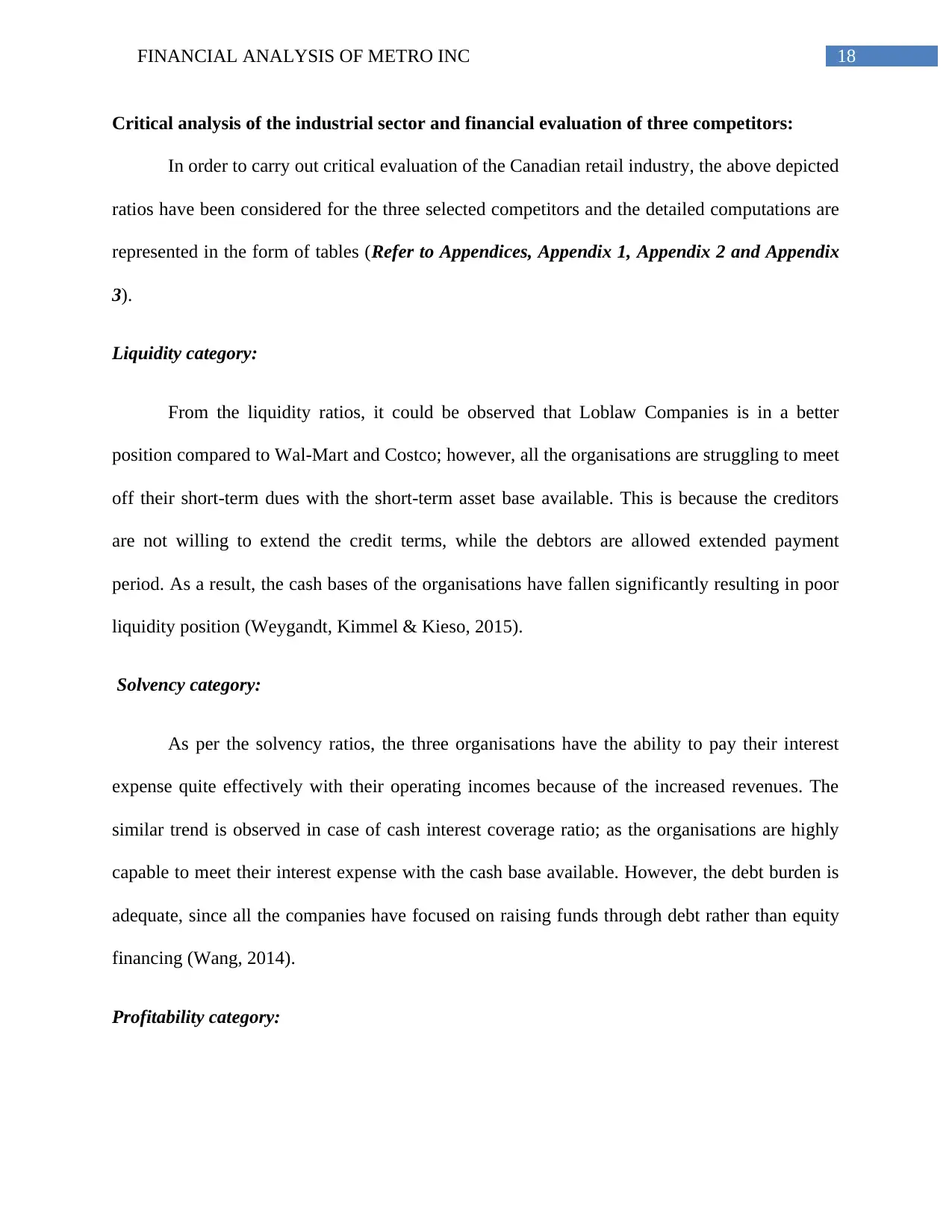
18FINANCIAL ANALYSIS OF METRO INC
Critical analysis of the industrial sector and financial evaluation of three competitors:
In order to carry out critical evaluation of the Canadian retail industry, the above depicted
ratios have been considered for the three selected competitors and the detailed computations are
represented in the form of tables (Refer to Appendices, Appendix 1, Appendix 2 and Appendix
3).
Liquidity category:
From the liquidity ratios, it could be observed that Loblaw Companies is in a better
position compared to Wal-Mart and Costco; however, all the organisations are struggling to meet
off their short-term dues with the short-term asset base available. This is because the creditors
are not willing to extend the credit terms, while the debtors are allowed extended payment
period. As a result, the cash bases of the organisations have fallen significantly resulting in poor
liquidity position (Weygandt, Kimmel & Kieso, 2015).
Solvency category:
As per the solvency ratios, the three organisations have the ability to pay their interest
expense quite effectively with their operating incomes because of the increased revenues. The
similar trend is observed in case of cash interest coverage ratio; as the organisations are highly
capable to meet their interest expense with the cash base available. However, the debt burden is
adequate, since all the companies have focused on raising funds through debt rather than equity
financing (Wang, 2014).
Profitability category:
Critical analysis of the industrial sector and financial evaluation of three competitors:
In order to carry out critical evaluation of the Canadian retail industry, the above depicted
ratios have been considered for the three selected competitors and the detailed computations are
represented in the form of tables (Refer to Appendices, Appendix 1, Appendix 2 and Appendix
3).
Liquidity category:
From the liquidity ratios, it could be observed that Loblaw Companies is in a better
position compared to Wal-Mart and Costco; however, all the organisations are struggling to meet
off their short-term dues with the short-term asset base available. This is because the creditors
are not willing to extend the credit terms, while the debtors are allowed extended payment
period. As a result, the cash bases of the organisations have fallen significantly resulting in poor
liquidity position (Weygandt, Kimmel & Kieso, 2015).
Solvency category:
As per the solvency ratios, the three organisations have the ability to pay their interest
expense quite effectively with their operating incomes because of the increased revenues. The
similar trend is observed in case of cash interest coverage ratio; as the organisations are highly
capable to meet their interest expense with the cash base available. However, the debt burden is
adequate, since all the companies have focused on raising funds through debt rather than equity
financing (Wang, 2014).
Profitability category:
Paraphrase This Document
Need a fresh take? Get an instant paraphrase of this document with our AI Paraphraser
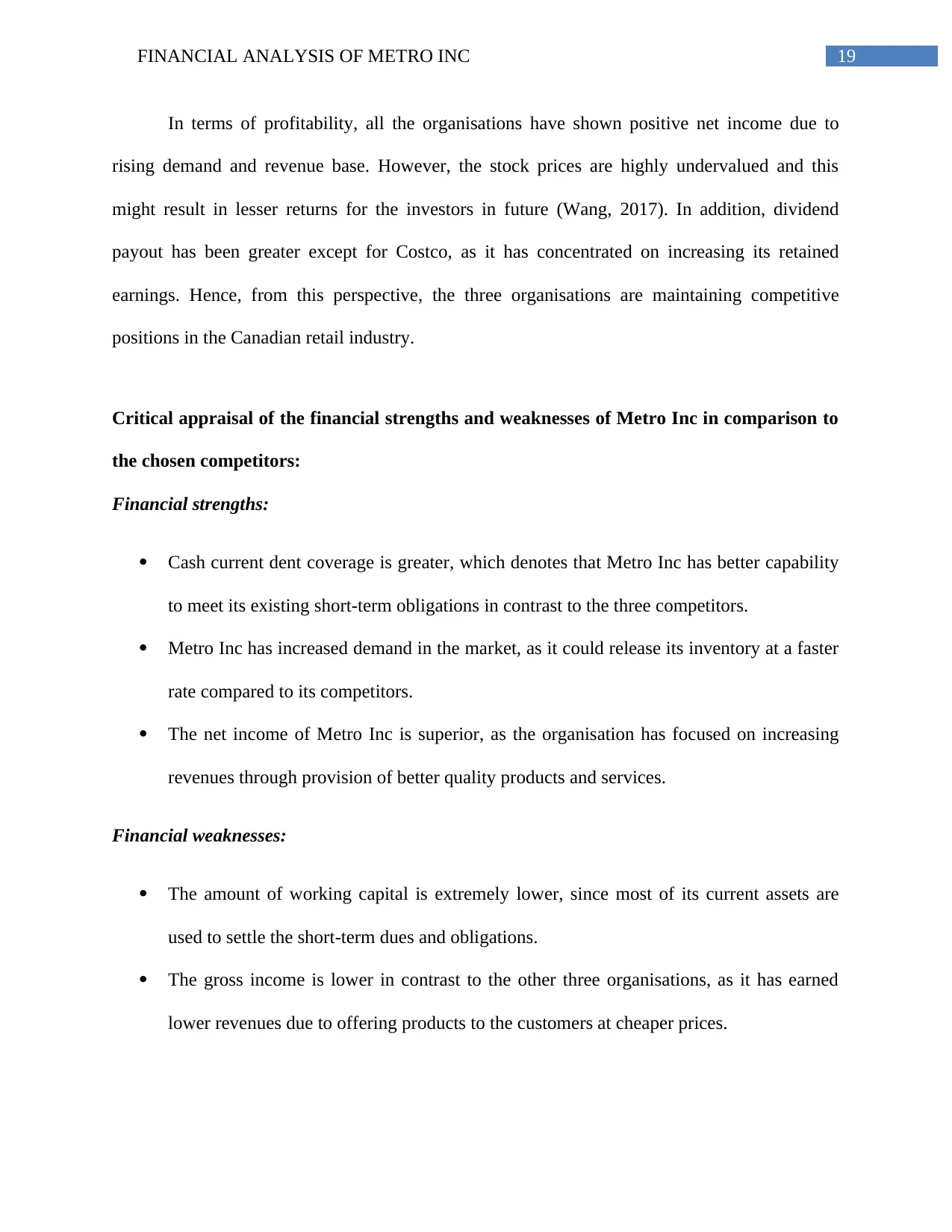
19FINANCIAL ANALYSIS OF METRO INC
In terms of profitability, all the organisations have shown positive net income due to
rising demand and revenue base. However, the stock prices are highly undervalued and this
might result in lesser returns for the investors in future (Wang, 2017). In addition, dividend
payout has been greater except for Costco, as it has concentrated on increasing its retained
earnings. Hence, from this perspective, the three organisations are maintaining competitive
positions in the Canadian retail industry.
Critical appraisal of the financial strengths and weaknesses of Metro Inc in comparison to
the chosen competitors:
Financial strengths:
Cash current dent coverage is greater, which denotes that Metro Inc has better capability
to meet its existing short-term obligations in contrast to the three competitors.
Metro Inc has increased demand in the market, as it could release its inventory at a faster
rate compared to its competitors.
The net income of Metro Inc is superior, as the organisation has focused on increasing
revenues through provision of better quality products and services.
Financial weaknesses:
The amount of working capital is extremely lower, since most of its current assets are
used to settle the short-term dues and obligations.
The gross income is lower in contrast to the other three organisations, as it has earned
lower revenues due to offering products to the customers at cheaper prices.
In terms of profitability, all the organisations have shown positive net income due to
rising demand and revenue base. However, the stock prices are highly undervalued and this
might result in lesser returns for the investors in future (Wang, 2017). In addition, dividend
payout has been greater except for Costco, as it has concentrated on increasing its retained
earnings. Hence, from this perspective, the three organisations are maintaining competitive
positions in the Canadian retail industry.
Critical appraisal of the financial strengths and weaknesses of Metro Inc in comparison to
the chosen competitors:
Financial strengths:
Cash current dent coverage is greater, which denotes that Metro Inc has better capability
to meet its existing short-term obligations in contrast to the three competitors.
Metro Inc has increased demand in the market, as it could release its inventory at a faster
rate compared to its competitors.
The net income of Metro Inc is superior, as the organisation has focused on increasing
revenues through provision of better quality products and services.
Financial weaknesses:
The amount of working capital is extremely lower, since most of its current assets are
used to settle the short-term dues and obligations.
The gross income is lower in contrast to the other three organisations, as it has earned
lower revenues due to offering products to the customers at cheaper prices.
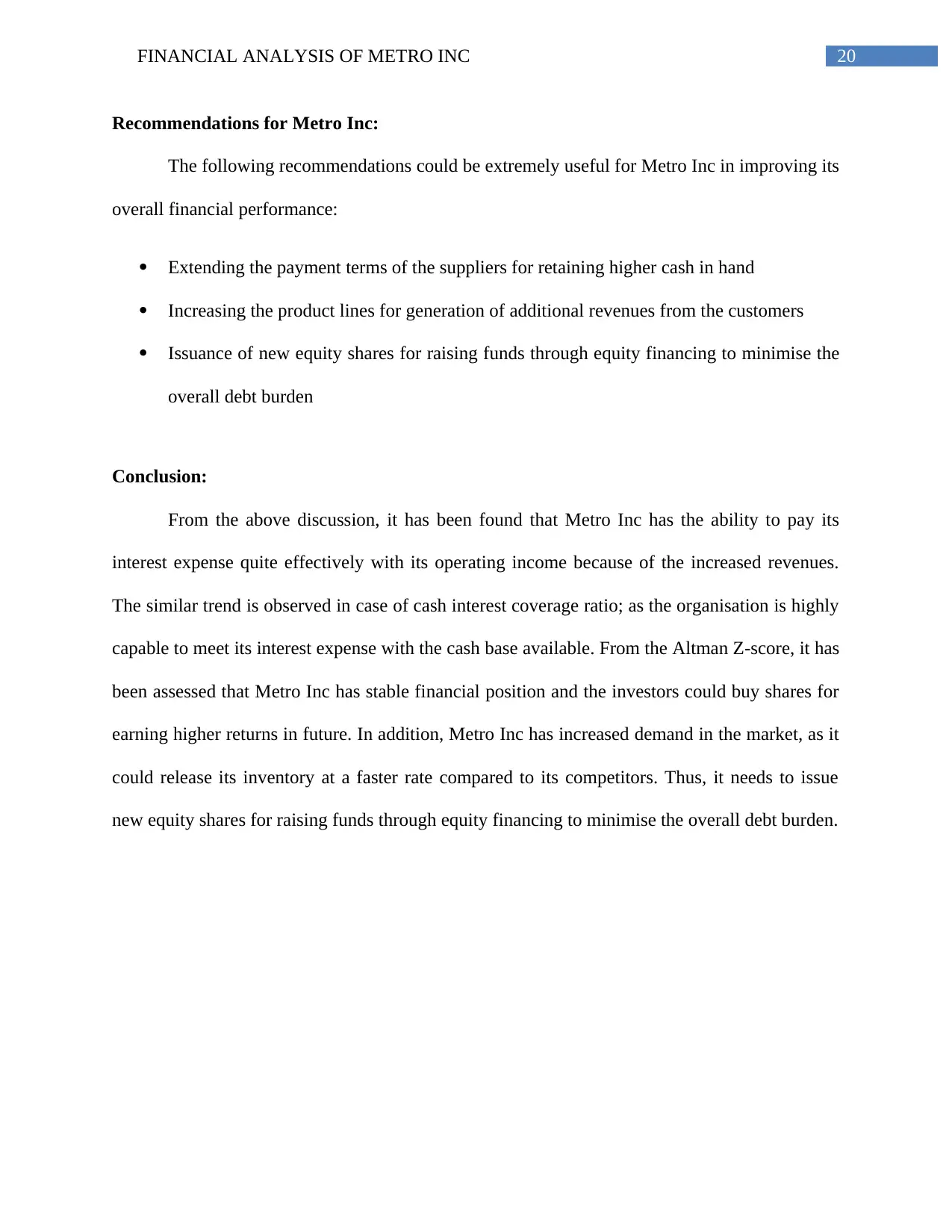
20FINANCIAL ANALYSIS OF METRO INC
Recommendations for Metro Inc:
The following recommendations could be extremely useful for Metro Inc in improving its
overall financial performance:
Extending the payment terms of the suppliers for retaining higher cash in hand
Increasing the product lines for generation of additional revenues from the customers
Issuance of new equity shares for raising funds through equity financing to minimise the
overall debt burden
Conclusion:
From the above discussion, it has been found that Metro Inc has the ability to pay its
interest expense quite effectively with its operating income because of the increased revenues.
The similar trend is observed in case of cash interest coverage ratio; as the organisation is highly
capable to meet its interest expense with the cash base available. From the Altman Z-score, it has
been assessed that Metro Inc has stable financial position and the investors could buy shares for
earning higher returns in future. In addition, Metro Inc has increased demand in the market, as it
could release its inventory at a faster rate compared to its competitors. Thus, it needs to issue
new equity shares for raising funds through equity financing to minimise the overall debt burden.
Recommendations for Metro Inc:
The following recommendations could be extremely useful for Metro Inc in improving its
overall financial performance:
Extending the payment terms of the suppliers for retaining higher cash in hand
Increasing the product lines for generation of additional revenues from the customers
Issuance of new equity shares for raising funds through equity financing to minimise the
overall debt burden
Conclusion:
From the above discussion, it has been found that Metro Inc has the ability to pay its
interest expense quite effectively with its operating income because of the increased revenues.
The similar trend is observed in case of cash interest coverage ratio; as the organisation is highly
capable to meet its interest expense with the cash base available. From the Altman Z-score, it has
been assessed that Metro Inc has stable financial position and the investors could buy shares for
earning higher returns in future. In addition, Metro Inc has increased demand in the market, as it
could release its inventory at a faster rate compared to its competitors. Thus, it needs to issue
new equity shares for raising funds through equity financing to minimise the overall debt burden.
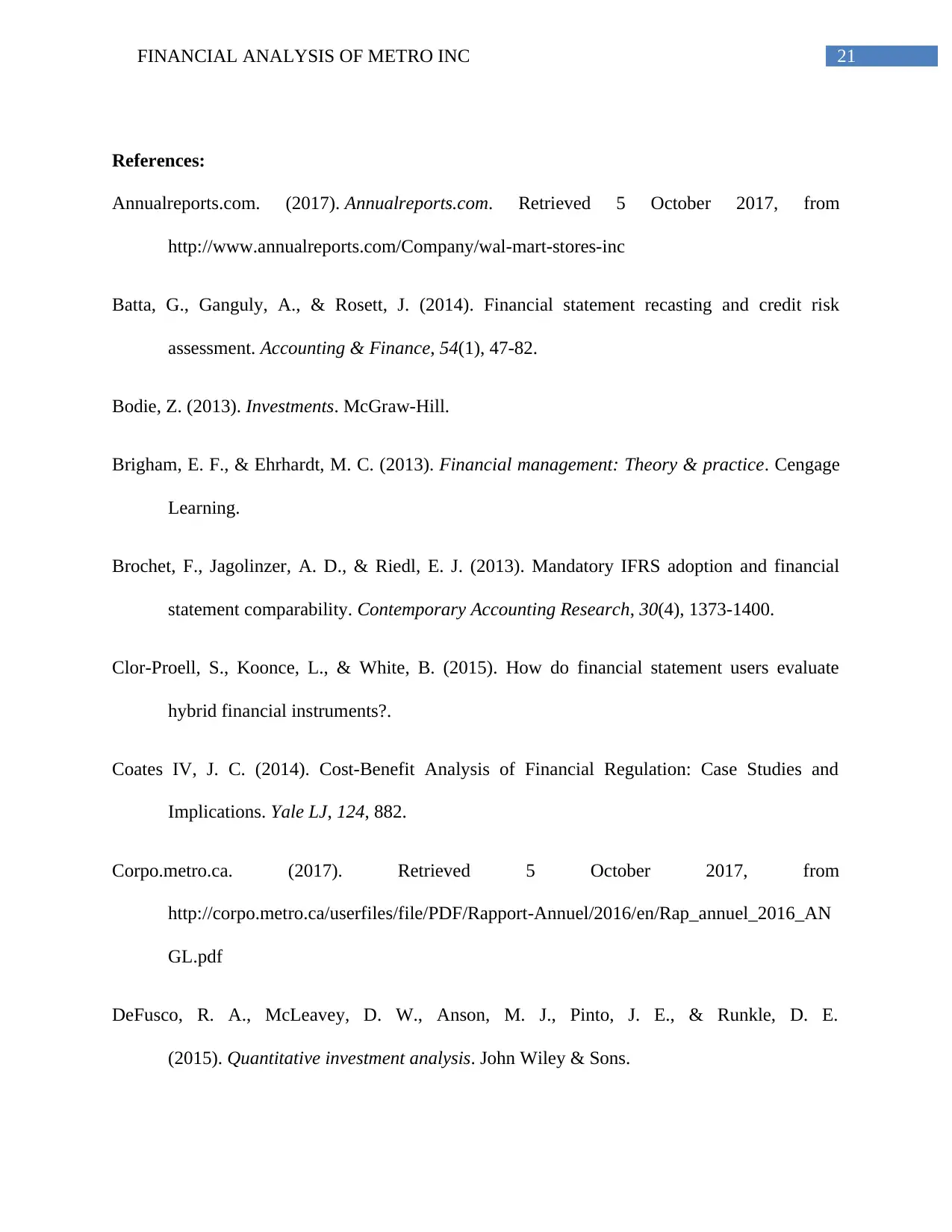
21FINANCIAL ANALYSIS OF METRO INC
References:
Annualreports.com. (2017). Annualreports.com. Retrieved 5 October 2017, from
http://www.annualreports.com/Company/wal-mart-stores-inc
Batta, G., Ganguly, A., & Rosett, J. (2014). Financial statement recasting and credit risk
assessment. Accounting & Finance, 54(1), 47-82.
Bodie, Z. (2013). Investments. McGraw-Hill.
Brigham, E. F., & Ehrhardt, M. C. (2013). Financial management: Theory & practice. Cengage
Learning.
Brochet, F., Jagolinzer, A. D., & Riedl, E. J. (2013). Mandatory IFRS adoption and financial
statement comparability. Contemporary Accounting Research, 30(4), 1373-1400.
Clor-Proell, S., Koonce, L., & White, B. (2015). How do financial statement users evaluate
hybrid financial instruments?.
Coates IV, J. C. (2014). Cost-Benefit Analysis of Financial Regulation: Case Studies and
Implications. Yale LJ, 124, 882.
Corpo.metro.ca. (2017). Retrieved 5 October 2017, from
http://corpo.metro.ca/userfiles/file/PDF/Rapport-Annuel/2016/en/Rap_annuel_2016_AN
GL.pdf
DeFusco, R. A., McLeavey, D. W., Anson, M. J., Pinto, J. E., & Runkle, D. E.
(2015). Quantitative investment analysis. John Wiley & Sons.
References:
Annualreports.com. (2017). Annualreports.com. Retrieved 5 October 2017, from
http://www.annualreports.com/Company/wal-mart-stores-inc
Batta, G., Ganguly, A., & Rosett, J. (2014). Financial statement recasting and credit risk
assessment. Accounting & Finance, 54(1), 47-82.
Bodie, Z. (2013). Investments. McGraw-Hill.
Brigham, E. F., & Ehrhardt, M. C. (2013). Financial management: Theory & practice. Cengage
Learning.
Brochet, F., Jagolinzer, A. D., & Riedl, E. J. (2013). Mandatory IFRS adoption and financial
statement comparability. Contemporary Accounting Research, 30(4), 1373-1400.
Clor-Proell, S., Koonce, L., & White, B. (2015). How do financial statement users evaluate
hybrid financial instruments?.
Coates IV, J. C. (2014). Cost-Benefit Analysis of Financial Regulation: Case Studies and
Implications. Yale LJ, 124, 882.
Corpo.metro.ca. (2017). Retrieved 5 October 2017, from
http://corpo.metro.ca/userfiles/file/PDF/Rapport-Annuel/2016/en/Rap_annuel_2016_AN
GL.pdf
DeFusco, R. A., McLeavey, D. W., Anson, M. J., Pinto, J. E., & Runkle, D. E.
(2015). Quantitative investment analysis. John Wiley & Sons.
Secure Best Marks with AI Grader
Need help grading? Try our AI Grader for instant feedback on your assignments.
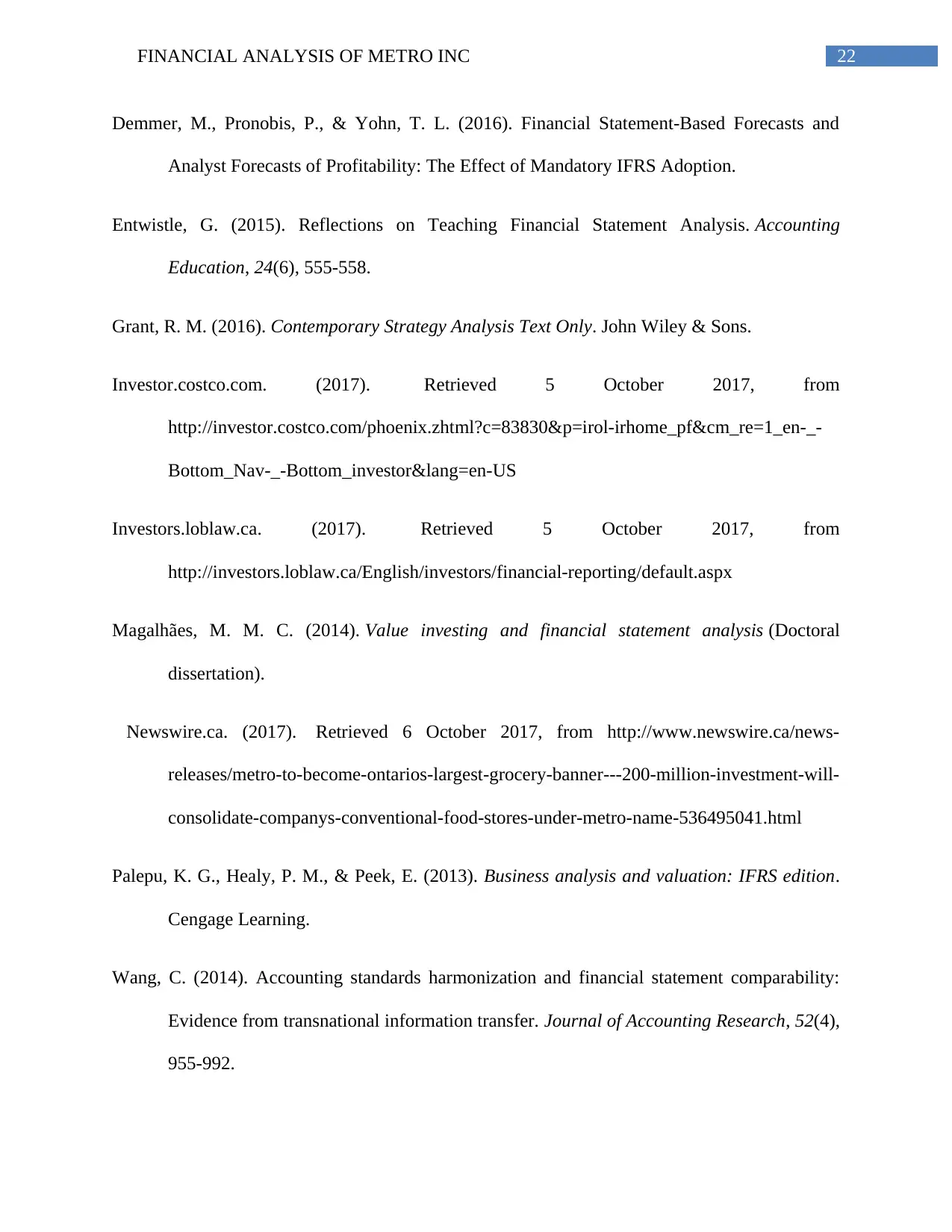
22FINANCIAL ANALYSIS OF METRO INC
Demmer, M., Pronobis, P., & Yohn, T. L. (2016). Financial Statement-Based Forecasts and
Analyst Forecasts of Profitability: The Effect of Mandatory IFRS Adoption.
Entwistle, G. (2015). Reflections on Teaching Financial Statement Analysis. Accounting
Education, 24(6), 555-558.
Grant, R. M. (2016). Contemporary Strategy Analysis Text Only. John Wiley & Sons.
Investor.costco.com. (2017). Retrieved 5 October 2017, from
http://investor.costco.com/phoenix.zhtml?c=83830&p=irol-irhome_pf&cm_re=1_en-_-
Bottom_Nav-_-Bottom_investor&lang=en-US
Investors.loblaw.ca. (2017). Retrieved 5 October 2017, from
http://investors.loblaw.ca/English/investors/financial-reporting/default.aspx
Magalhães, M. M. C. (2014). Value investing and financial statement analysis (Doctoral
dissertation).
Newswire.ca. (2017). Retrieved 6 October 2017, from http://www.newswire.ca/news-
releases/metro-to-become-ontarios-largest-grocery-banner---200-million-investment-will-
consolidate-companys-conventional-food-stores-under-metro-name-536495041.html
Palepu, K. G., Healy, P. M., & Peek, E. (2013). Business analysis and valuation: IFRS edition.
Cengage Learning.
Wang, C. (2014). Accounting standards harmonization and financial statement comparability:
Evidence from transnational information transfer. Journal of Accounting Research, 52(4),
955-992.
Demmer, M., Pronobis, P., & Yohn, T. L. (2016). Financial Statement-Based Forecasts and
Analyst Forecasts of Profitability: The Effect of Mandatory IFRS Adoption.
Entwistle, G. (2015). Reflections on Teaching Financial Statement Analysis. Accounting
Education, 24(6), 555-558.
Grant, R. M. (2016). Contemporary Strategy Analysis Text Only. John Wiley & Sons.
Investor.costco.com. (2017). Retrieved 5 October 2017, from
http://investor.costco.com/phoenix.zhtml?c=83830&p=irol-irhome_pf&cm_re=1_en-_-
Bottom_Nav-_-Bottom_investor&lang=en-US
Investors.loblaw.ca. (2017). Retrieved 5 October 2017, from
http://investors.loblaw.ca/English/investors/financial-reporting/default.aspx
Magalhães, M. M. C. (2014). Value investing and financial statement analysis (Doctoral
dissertation).
Newswire.ca. (2017). Retrieved 6 October 2017, from http://www.newswire.ca/news-
releases/metro-to-become-ontarios-largest-grocery-banner---200-million-investment-will-
consolidate-companys-conventional-food-stores-under-metro-name-536495041.html
Palepu, K. G., Healy, P. M., & Peek, E. (2013). Business analysis and valuation: IFRS edition.
Cengage Learning.
Wang, C. (2014). Accounting standards harmonization and financial statement comparability:
Evidence from transnational information transfer. Journal of Accounting Research, 52(4),
955-992.
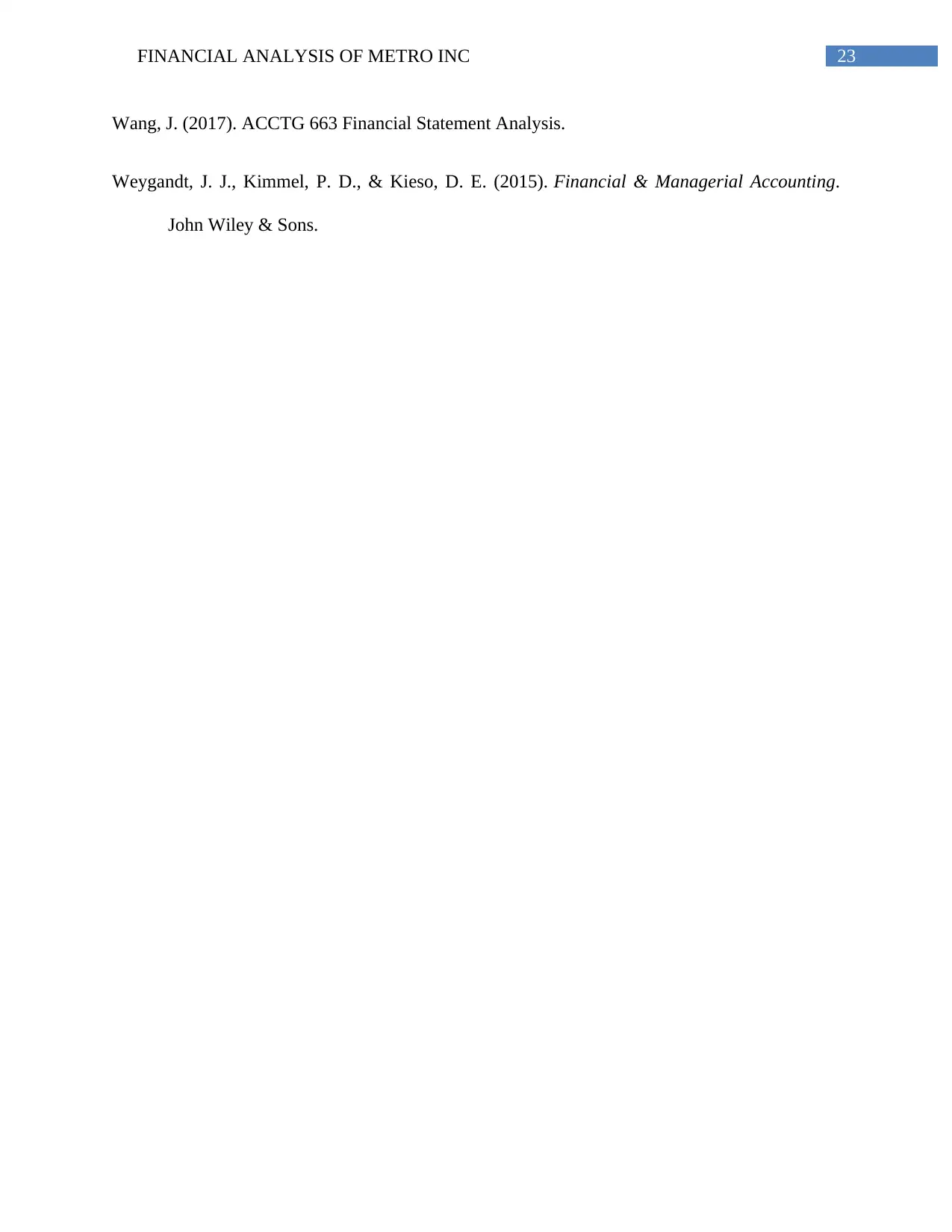
23FINANCIAL ANALYSIS OF METRO INC
Wang, J. (2017). ACCTG 663 Financial Statement Analysis.
Weygandt, J. J., Kimmel, P. D., & Kieso, D. E. (2015). Financial & Managerial Accounting.
John Wiley & Sons.
Wang, J. (2017). ACCTG 663 Financial Statement Analysis.
Weygandt, J. J., Kimmel, P. D., & Kieso, D. E. (2015). Financial & Managerial Accounting.
John Wiley & Sons.
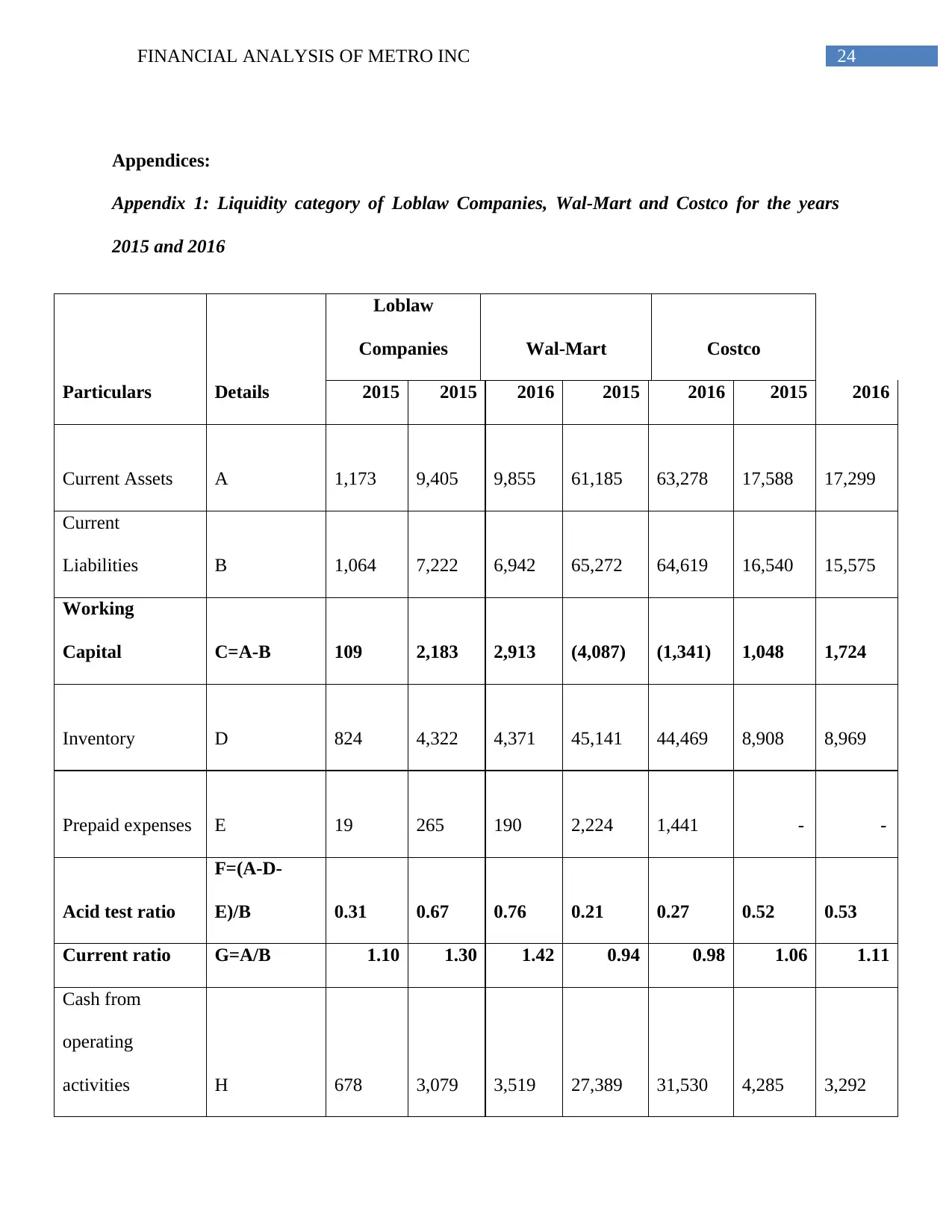
24FINANCIAL ANALYSIS OF METRO INC
Appendices:
Appendix 1: Liquidity category of Loblaw Companies, Wal-Mart and Costco for the years
2015 and 2016
Particulars Details
Loblaw
Companies Wal-Mart Costco
2015 2015 2016 2015 2016 2015 2016
Current Assets A 1,173 9,405 9,855 61,185 63,278 17,588 17,299
Current
Liabilities B 1,064 7,222 6,942 65,272 64,619 16,540 15,575
Working
Capital C=A-B 109 2,183 2,913 (4,087) (1,341) 1,048 1,724
Inventory D 824 4,322 4,371 45,141 44,469 8,908 8,969
Prepaid expenses E 19 265 190 2,224 1,441 - -
Acid test ratio
F=(A-D-
E)/B 0.31 0.67 0.76 0.21 0.27 0.52 0.53
Current ratio G=A/B 1.10 1.30 1.42 0.94 0.98 1.06 1.11
Cash from
operating
activities H 678 3,079 3,519 27,389 31,530 4,285 3,292
Appendices:
Appendix 1: Liquidity category of Loblaw Companies, Wal-Mart and Costco for the years
2015 and 2016
Particulars Details
Loblaw
Companies Wal-Mart Costco
2015 2015 2016 2015 2016 2015 2016
Current Assets A 1,173 9,405 9,855 61,185 63,278 17,588 17,299
Current
Liabilities B 1,064 7,222 6,942 65,272 64,619 16,540 15,575
Working
Capital C=A-B 109 2,183 2,913 (4,087) (1,341) 1,048 1,724
Inventory D 824 4,322 4,371 45,141 44,469 8,908 8,969
Prepaid expenses E 19 265 190 2,224 1,441 - -
Acid test ratio
F=(A-D-
E)/B 0.31 0.67 0.76 0.21 0.27 0.52 0.53
Current ratio G=A/B 1.10 1.30 1.42 0.94 0.98 1.06 1.11
Cash from
operating
activities H 678 3,079 3,519 27,389 31,530 4,285 3,292
Paraphrase This Document
Need a fresh take? Get an instant paraphrase of this document with our AI Paraphraser
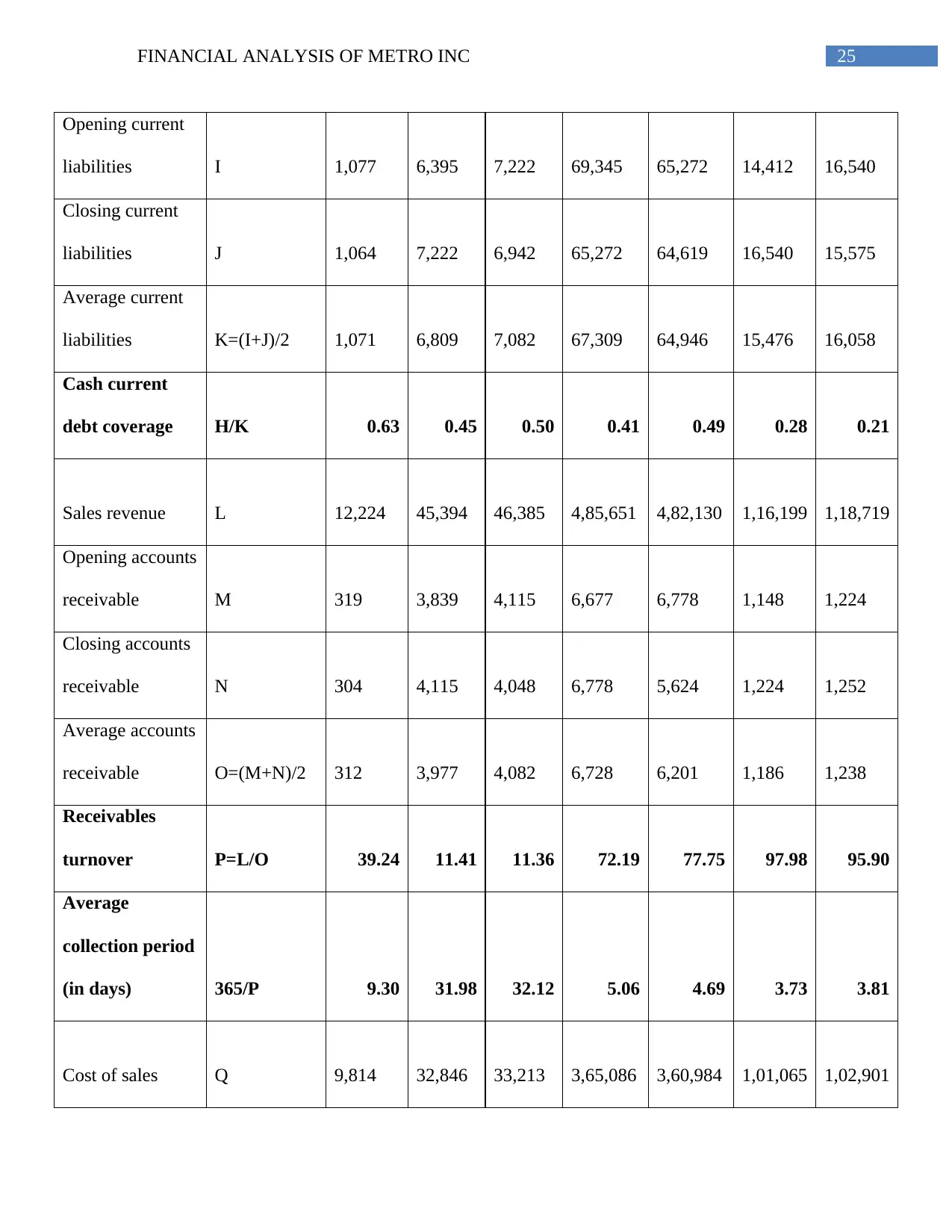
25FINANCIAL ANALYSIS OF METRO INC
Opening current
liabilities I 1,077 6,395 7,222 69,345 65,272 14,412 16,540
Closing current
liabilities J 1,064 7,222 6,942 65,272 64,619 16,540 15,575
Average current
liabilities K=(I+J)/2 1,071 6,809 7,082 67,309 64,946 15,476 16,058
Cash current
debt coverage H/K 0.63 0.45 0.50 0.41 0.49 0.28 0.21
Sales revenue L 12,224 45,394 46,385 4,85,651 4,82,130 1,16,199 1,18,719
Opening accounts
receivable M 319 3,839 4,115 6,677 6,778 1,148 1,224
Closing accounts
receivable N 304 4,115 4,048 6,778 5,624 1,224 1,252
Average accounts
receivable O=(M+N)/2 312 3,977 4,082 6,728 6,201 1,186 1,238
Receivables
turnover P=L/O 39.24 11.41 11.36 72.19 77.75 97.98 95.90
Average
collection period
(in days) 365/P 9.30 31.98 32.12 5.06 4.69 3.73 3.81
Cost of sales Q 9,814 32,846 33,213 3,65,086 3,60,984 1,01,065 1,02,901
Opening current
liabilities I 1,077 6,395 7,222 69,345 65,272 14,412 16,540
Closing current
liabilities J 1,064 7,222 6,942 65,272 64,619 16,540 15,575
Average current
liabilities K=(I+J)/2 1,071 6,809 7,082 67,309 64,946 15,476 16,058
Cash current
debt coverage H/K 0.63 0.45 0.50 0.41 0.49 0.28 0.21
Sales revenue L 12,224 45,394 46,385 4,85,651 4,82,130 1,16,199 1,18,719
Opening accounts
receivable M 319 3,839 4,115 6,677 6,778 1,148 1,224
Closing accounts
receivable N 304 4,115 4,048 6,778 5,624 1,224 1,252
Average accounts
receivable O=(M+N)/2 312 3,977 4,082 6,728 6,201 1,186 1,238
Receivables
turnover P=L/O 39.24 11.41 11.36 72.19 77.75 97.98 95.90
Average
collection period
(in days) 365/P 9.30 31.98 32.12 5.06 4.69 3.73 3.81
Cost of sales Q 9,814 32,846 33,213 3,65,086 3,60,984 1,01,065 1,02,901
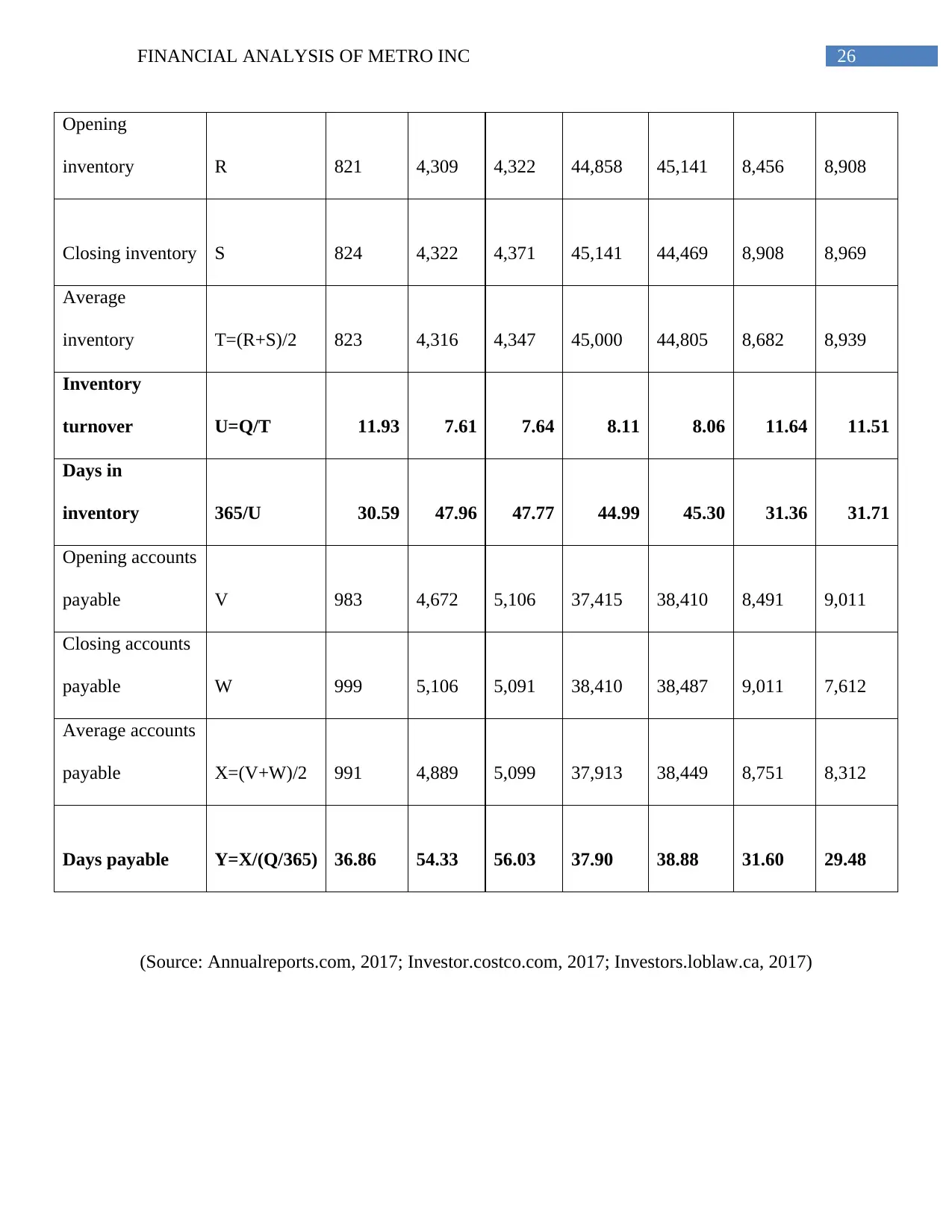
26FINANCIAL ANALYSIS OF METRO INC
Opening
inventory R 821 4,309 4,322 44,858 45,141 8,456 8,908
Closing inventory S 824 4,322 4,371 45,141 44,469 8,908 8,969
Average
inventory T=(R+S)/2 823 4,316 4,347 45,000 44,805 8,682 8,939
Inventory
turnover U=Q/T 11.93 7.61 7.64 8.11 8.06 11.64 11.51
Days in
inventory 365/U 30.59 47.96 47.77 44.99 45.30 31.36 31.71
Opening accounts
payable V 983 4,672 5,106 37,415 38,410 8,491 9,011
Closing accounts
payable W 999 5,106 5,091 38,410 38,487 9,011 7,612
Average accounts
payable X=(V+W)/2 991 4,889 5,099 37,913 38,449 8,751 8,312
Days payable Y=X/(Q/365) 36.86 54.33 56.03 37.90 38.88 31.60 29.48
(Source: Annualreports.com, 2017; Investor.costco.com, 2017; Investors.loblaw.ca, 2017)
Opening
inventory R 821 4,309 4,322 44,858 45,141 8,456 8,908
Closing inventory S 824 4,322 4,371 45,141 44,469 8,908 8,969
Average
inventory T=(R+S)/2 823 4,316 4,347 45,000 44,805 8,682 8,939
Inventory
turnover U=Q/T 11.93 7.61 7.64 8.11 8.06 11.64 11.51
Days in
inventory 365/U 30.59 47.96 47.77 44.99 45.30 31.36 31.71
Opening accounts
payable V 983 4,672 5,106 37,415 38,410 8,491 9,011
Closing accounts
payable W 999 5,106 5,091 38,410 38,487 9,011 7,612
Average accounts
payable X=(V+W)/2 991 4,889 5,099 37,913 38,449 8,751 8,312
Days payable Y=X/(Q/365) 36.86 54.33 56.03 37.90 38.88 31.60 29.48
(Source: Annualreports.com, 2017; Investor.costco.com, 2017; Investors.loblaw.ca, 2017)

27FINANCIAL ANALYSIS OF METRO INC
Appendix 2: Solvency category of Loblaw Companies, Wal-Mart and Costco for the years 2015
and 2016
Particulars Details
Loblaw Companies Wal-Mart Costco
2015 2015 2016 2015 2016 2015 2016
Total
liabilities A 2,744 20,788 21,434 1,22,312 1,19,035 22,823 21,084
Total assets B 5,387 33,939 34,436 2,03,706 1,99,581 33,440 33,163
Debt to total
assets C=A/B 0.51 0.61 0.62 0.60 0.60 0.68 0.64
EBIT D 681 1,601 2,092 27,147 24,105 3,624 3,672
Interest
expense E 60 674 488 2,461 2,548 124 133
Times
interest
earned F=D/E 11.35 2.38 4.29 11.03 9.46 29.23 27.61
EBITDA G 917 3,223 3,470 36,433 33,640 4,855 5,007
Cash interest
coverage G/E 15.28 4.78 7.11 14.80 13.20 39.15 37.65
Cash from
operating
H
678 3,079 3,519 27,389 31,530 4,285 3,292
Appendix 2: Solvency category of Loblaw Companies, Wal-Mart and Costco for the years 2015
and 2016
Particulars Details
Loblaw Companies Wal-Mart Costco
2015 2015 2016 2015 2016 2015 2016
Total
liabilities A 2,744 20,788 21,434 1,22,312 1,19,035 22,823 21,084
Total assets B 5,387 33,939 34,436 2,03,706 1,99,581 33,440 33,163
Debt to total
assets C=A/B 0.51 0.61 0.62 0.60 0.60 0.68 0.64
EBIT D 681 1,601 2,092 27,147 24,105 3,624 3,672
Interest
expense E 60 674 488 2,461 2,548 124 133
Times
interest
earned F=D/E 11.35 2.38 4.29 11.03 9.46 29.23 27.61
EBITDA G 917 3,223 3,470 36,433 33,640 4,855 5,007
Cash interest
coverage G/E 15.28 4.78 7.11 14.80 13.20 39.15 37.65
Cash from
operating
H
678 3,079 3,519 27,389 31,530 4,285 3,292
Secure Best Marks with AI Grader
Need help grading? Try our AI Grader for instant feedback on your assignments.
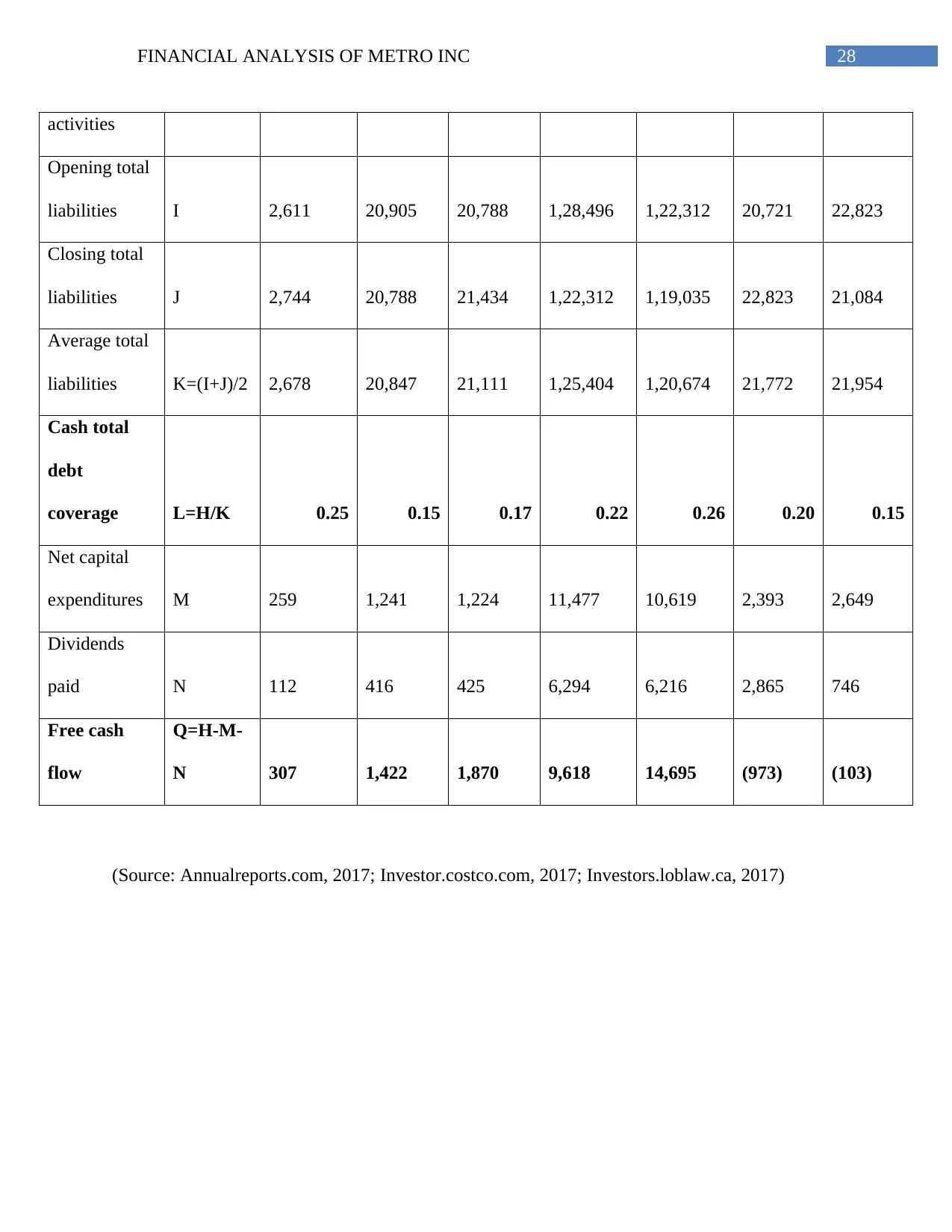
28FINANCIAL ANALYSIS OF METRO INC
activities
Opening total
liabilities I 2,611 20,905 20,788 1,28,496 1,22,312 20,721 22,823
Closing total
liabilities J 2,744 20,788 21,434 1,22,312 1,19,035 22,823 21,084
Average total
liabilities K=(I+J)/2 2,678 20,847 21,111 1,25,404 1,20,674 21,772 21,954
Cash total
debt
coverage L=H/K 0.25 0.15 0.17 0.22 0.26 0.20 0.15
Net capital
expenditures M 259 1,241 1,224 11,477 10,619 2,393 2,649
Dividends
paid N 112 416 425 6,294 6,216 2,865 746
Free cash
flow
Q=H-M-
N 307 1,422 1,870 9,618 14,695 (973) (103)
(Source: Annualreports.com, 2017; Investor.costco.com, 2017; Investors.loblaw.ca, 2017)
activities
Opening total
liabilities I 2,611 20,905 20,788 1,28,496 1,22,312 20,721 22,823
Closing total
liabilities J 2,744 20,788 21,434 1,22,312 1,19,035 22,823 21,084
Average total
liabilities K=(I+J)/2 2,678 20,847 21,111 1,25,404 1,20,674 21,772 21,954
Cash total
debt
coverage L=H/K 0.25 0.15 0.17 0.22 0.26 0.20 0.15
Net capital
expenditures M 259 1,241 1,224 11,477 10,619 2,393 2,649
Dividends
paid N 112 416 425 6,294 6,216 2,865 746
Free cash
flow
Q=H-M-
N 307 1,422 1,870 9,618 14,695 (973) (103)
(Source: Annualreports.com, 2017; Investor.costco.com, 2017; Investors.loblaw.ca, 2017)
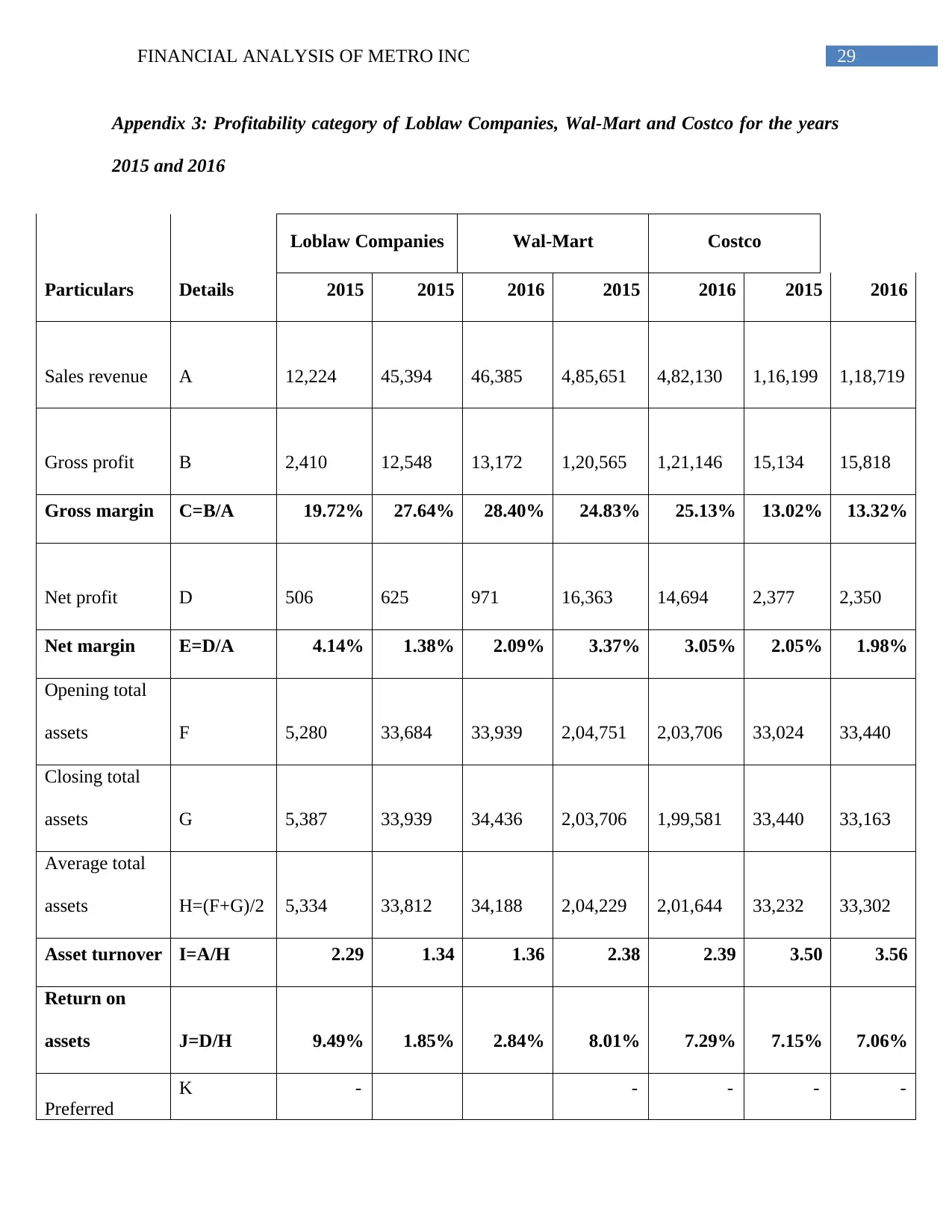
29FINANCIAL ANALYSIS OF METRO INC
Appendix 3: Profitability category of Loblaw Companies, Wal-Mart and Costco for the years
2015 and 2016
Particulars Details
Loblaw Companies Wal-Mart Costco
2015 2015 2016 2015 2016 2015 2016
Sales revenue A 12,224 45,394 46,385 4,85,651 4,82,130 1,16,199 1,18,719
Gross profit B 2,410 12,548 13,172 1,20,565 1,21,146 15,134 15,818
Gross margin C=B/A 19.72% 27.64% 28.40% 24.83% 25.13% 13.02% 13.32%
Net profit D 506 625 971 16,363 14,694 2,377 2,350
Net margin E=D/A 4.14% 1.38% 2.09% 3.37% 3.05% 2.05% 1.98%
Opening total
assets F 5,280 33,684 33,939 2,04,751 2,03,706 33,024 33,440
Closing total
assets G 5,387 33,939 34,436 2,03,706 1,99,581 33,440 33,163
Average total
assets H=(F+G)/2 5,334 33,812 34,188 2,04,229 2,01,644 33,232 33,302
Asset turnover I=A/H 2.29 1.34 1.36 2.38 2.39 3.50 3.56
Return on
assets J=D/H 9.49% 1.85% 2.84% 8.01% 7.29% 7.15% 7.06%
Preferred
K - - - - -
Appendix 3: Profitability category of Loblaw Companies, Wal-Mart and Costco for the years
2015 and 2016
Particulars Details
Loblaw Companies Wal-Mart Costco
2015 2015 2016 2015 2016 2015 2016
Sales revenue A 12,224 45,394 46,385 4,85,651 4,82,130 1,16,199 1,18,719
Gross profit B 2,410 12,548 13,172 1,20,565 1,21,146 15,134 15,818
Gross margin C=B/A 19.72% 27.64% 28.40% 24.83% 25.13% 13.02% 13.32%
Net profit D 506 625 971 16,363 14,694 2,377 2,350
Net margin E=D/A 4.14% 1.38% 2.09% 3.37% 3.05% 2.05% 1.98%
Opening total
assets F 5,280 33,684 33,939 2,04,751 2,03,706 33,024 33,440
Closing total
assets G 5,387 33,939 34,436 2,03,706 1,99,581 33,440 33,163
Average total
assets H=(F+G)/2 5,334 33,812 34,188 2,04,229 2,01,644 33,232 33,302
Asset turnover I=A/H 2.29 1.34 1.36 2.38 2.39 3.50 3.56
Return on
assets J=D/H 9.49% 1.85% 2.84% 8.01% 7.29% 7.15% 7.06%
Preferred
K - - - - -
1 out of 30
Your All-in-One AI-Powered Toolkit for Academic Success.
+13062052269
info@desklib.com
Available 24*7 on WhatsApp / Email
![[object Object]](/_next/static/media/star-bottom.7253800d.svg)
Unlock your academic potential
© 2024 | Zucol Services PVT LTD | All rights reserved.

